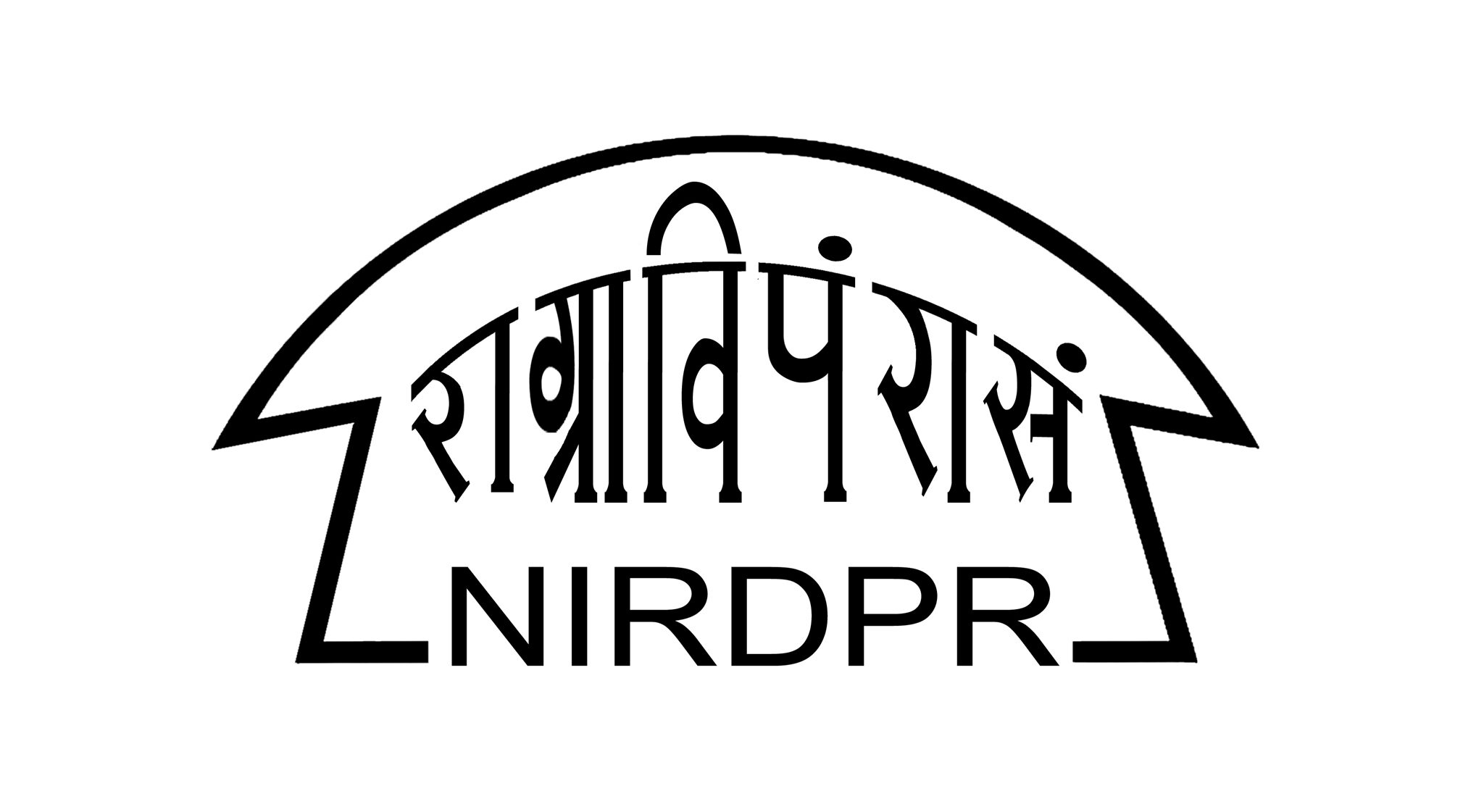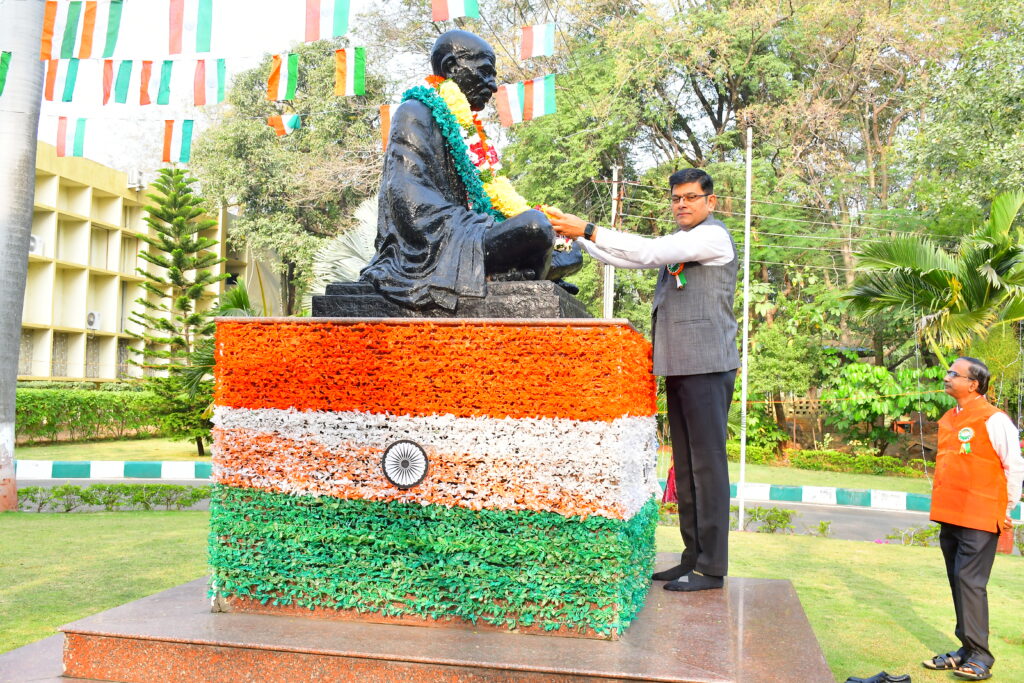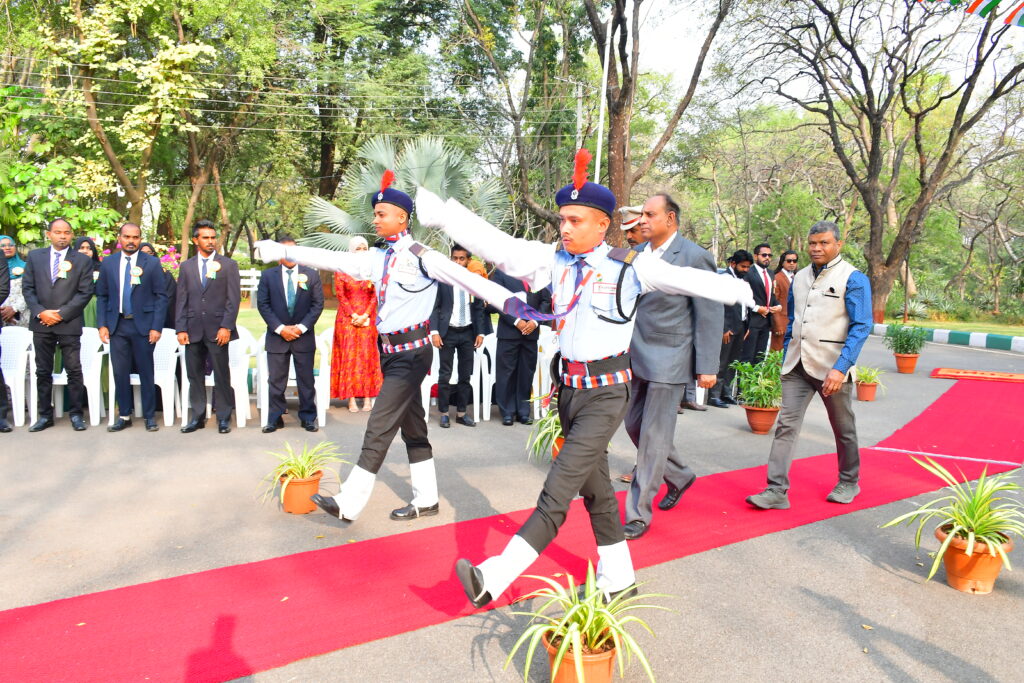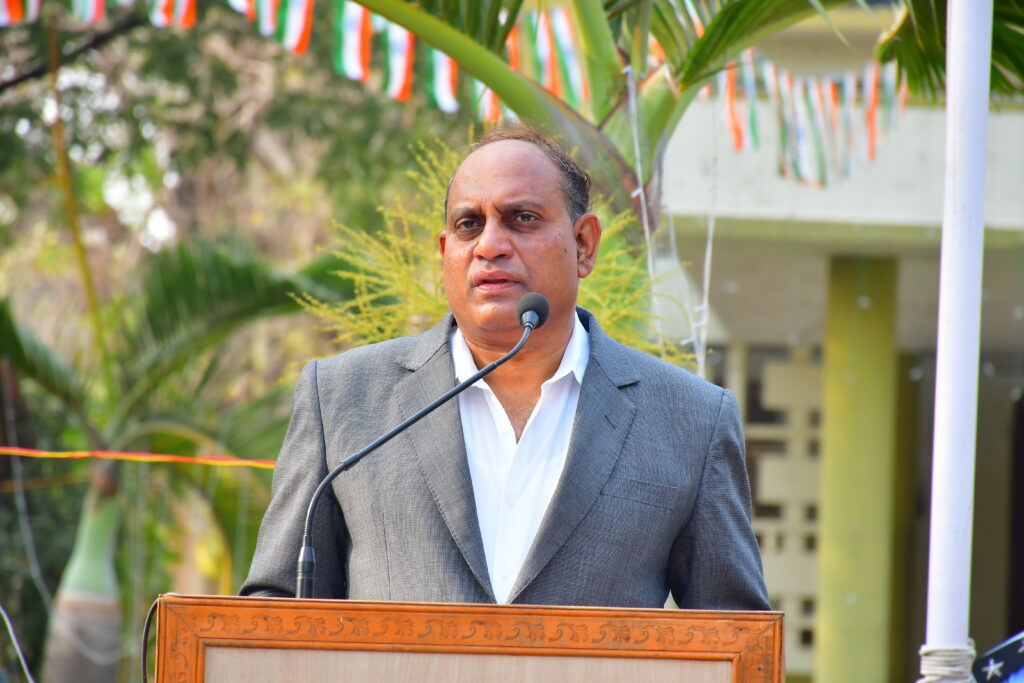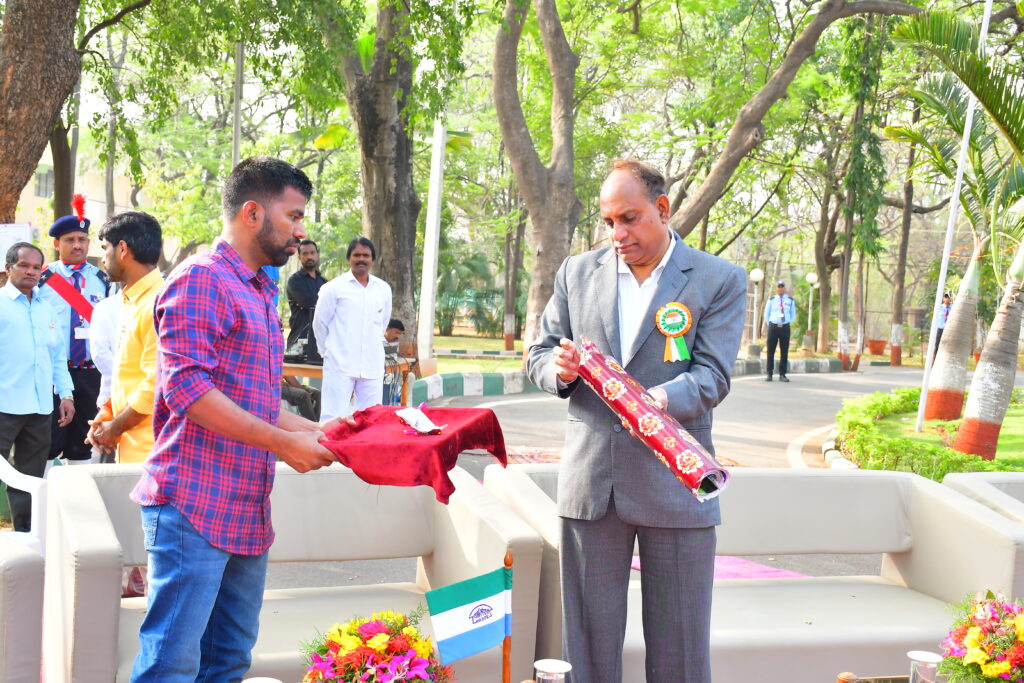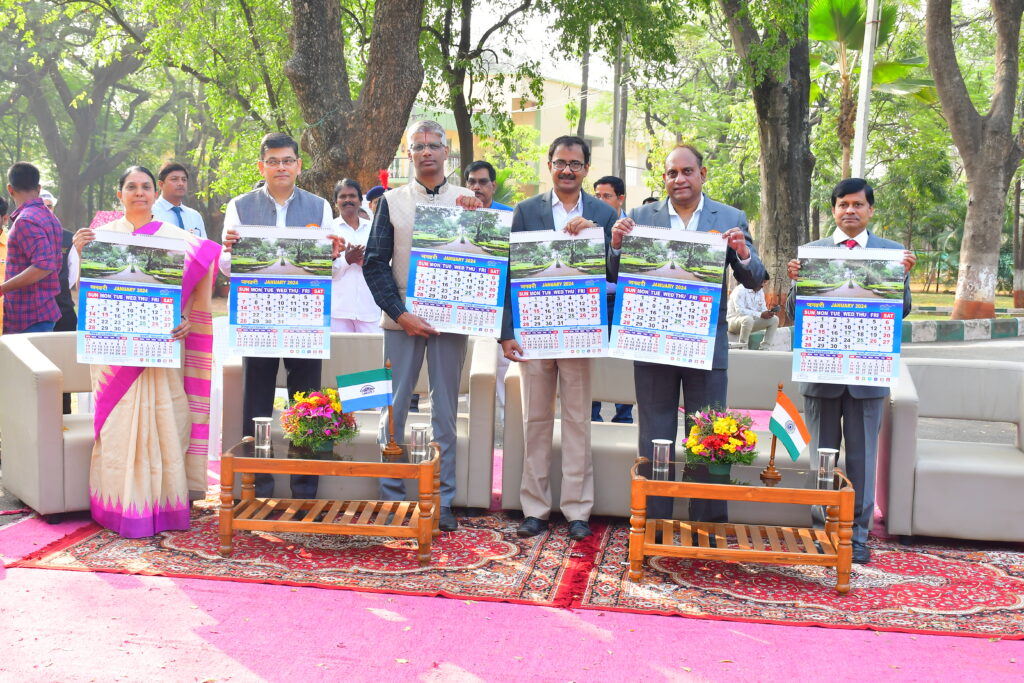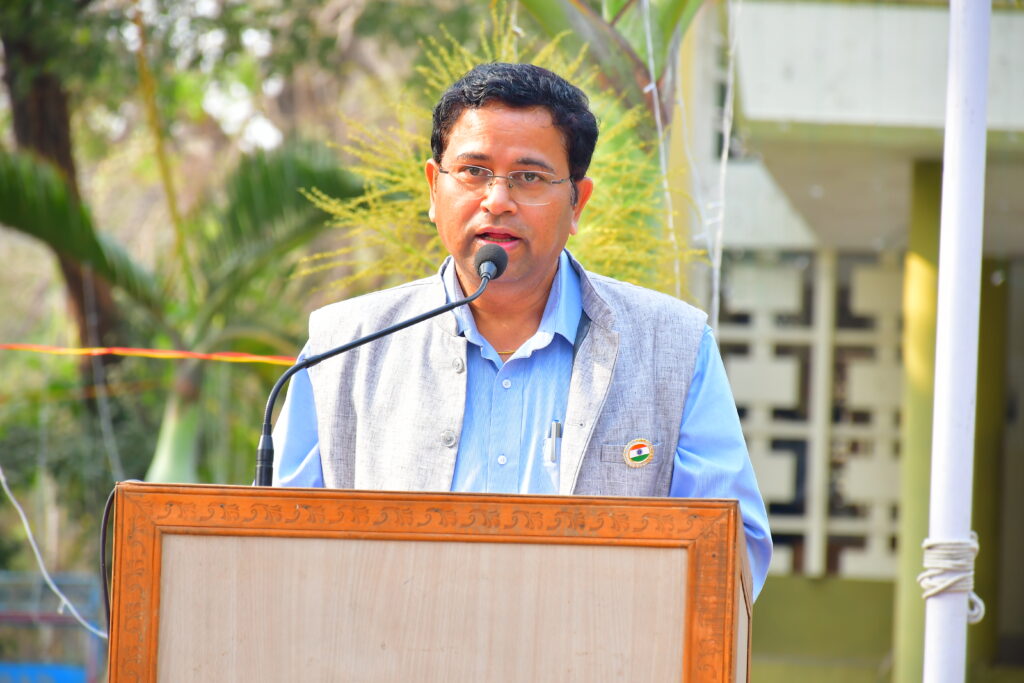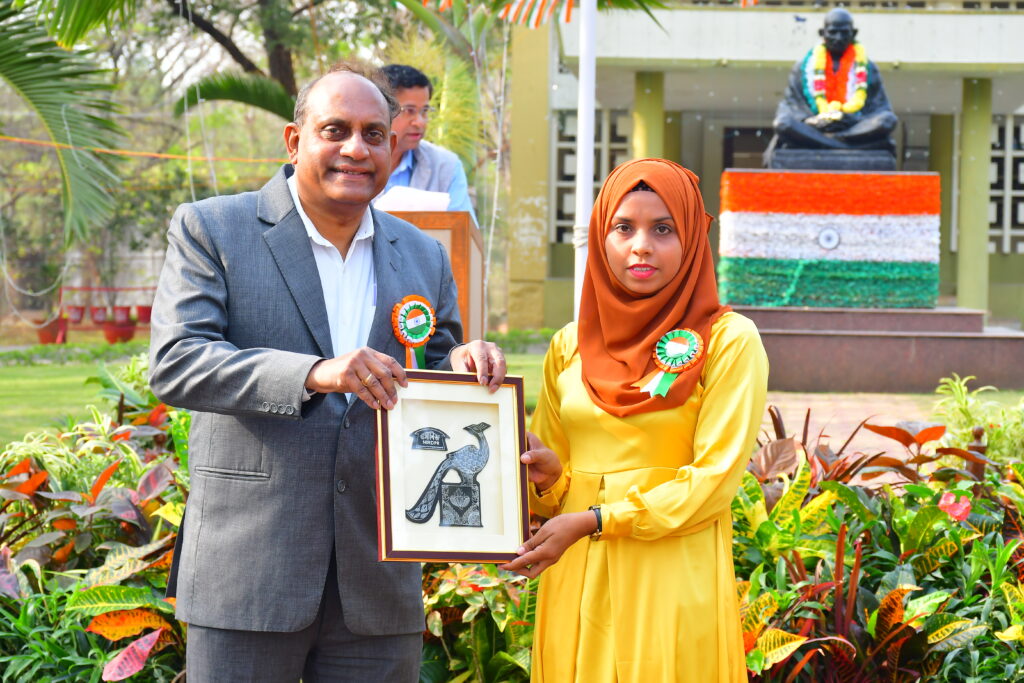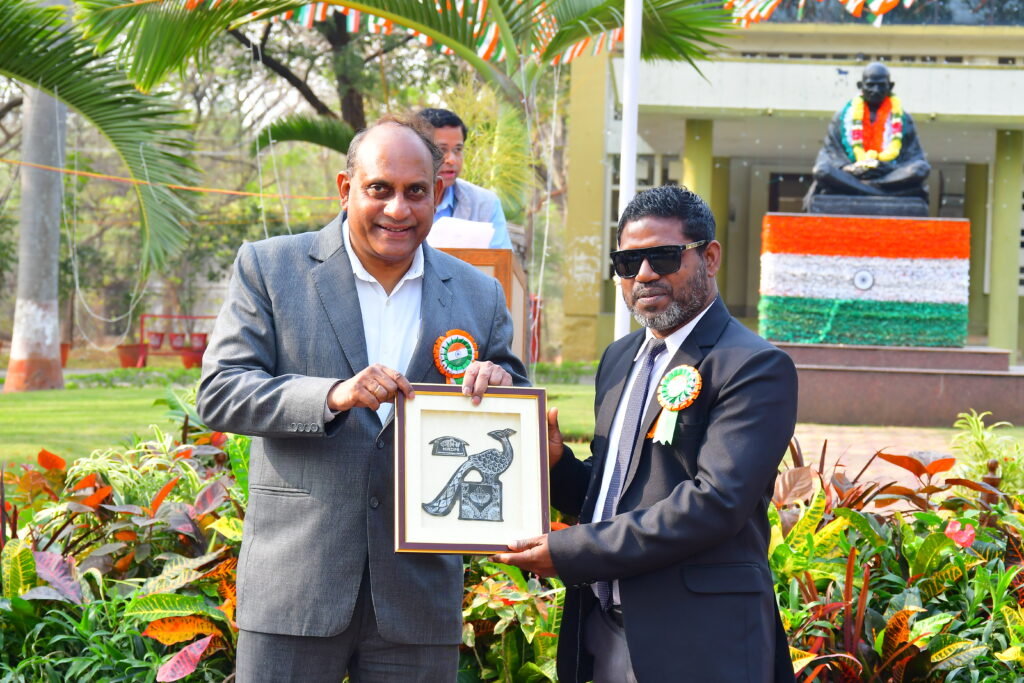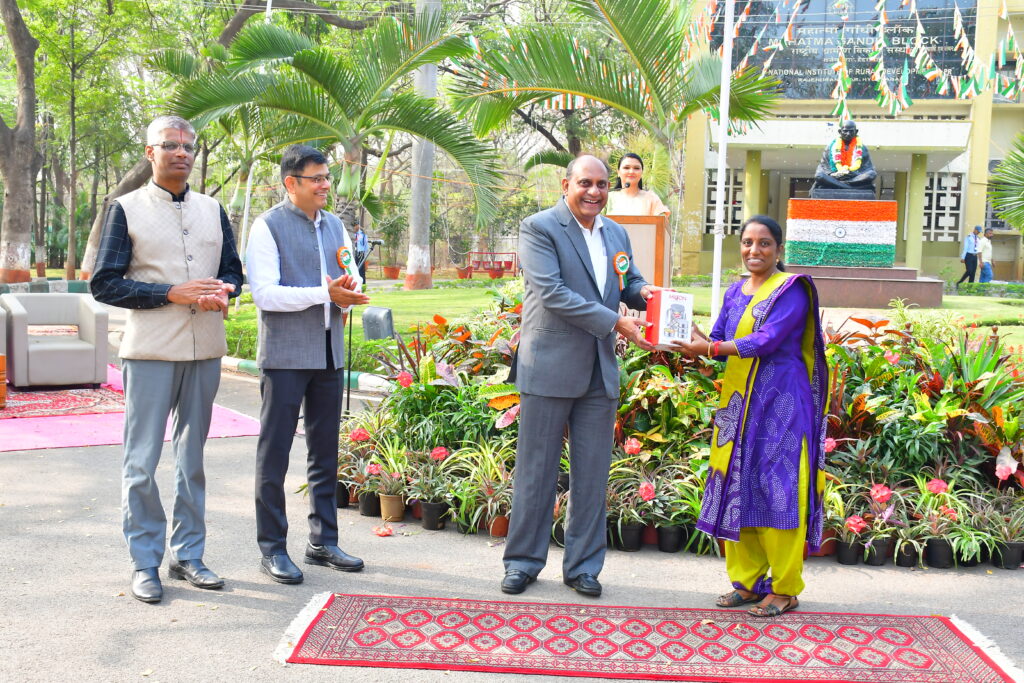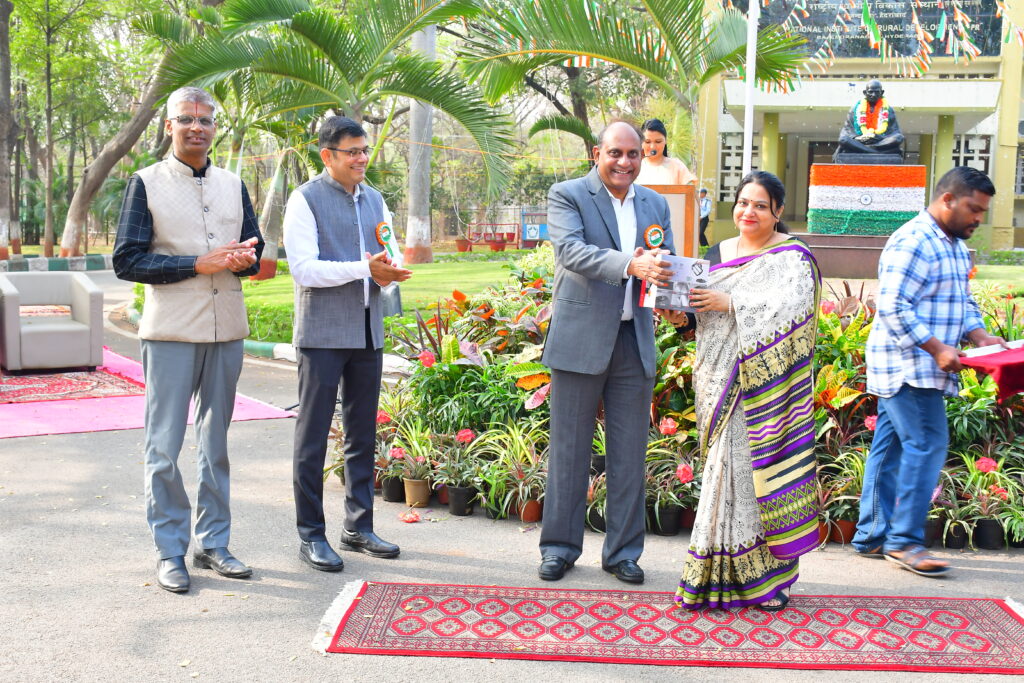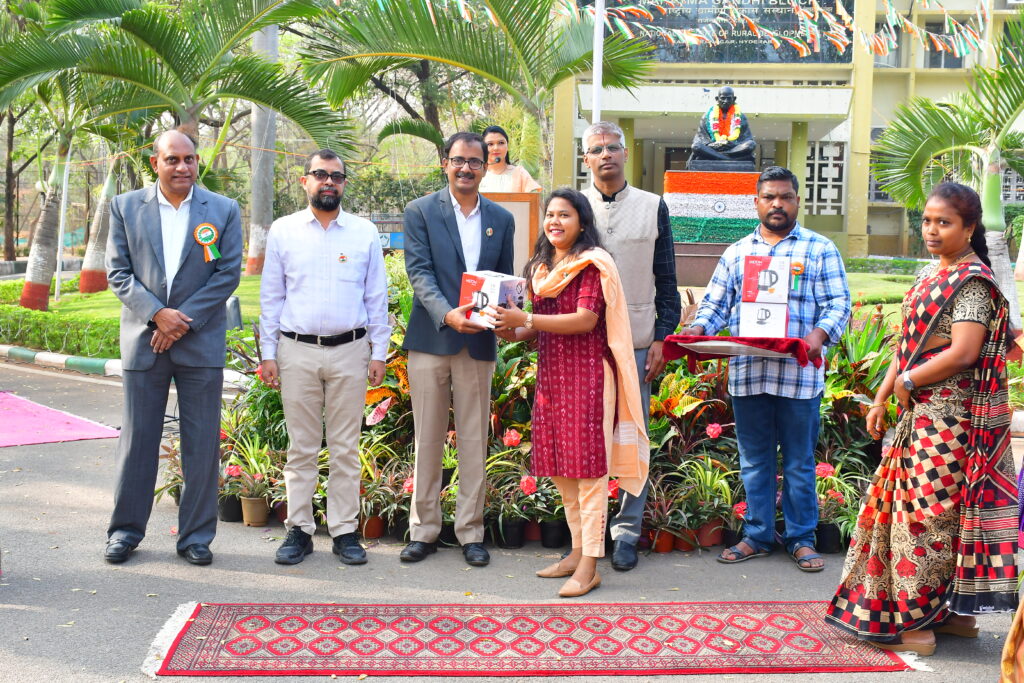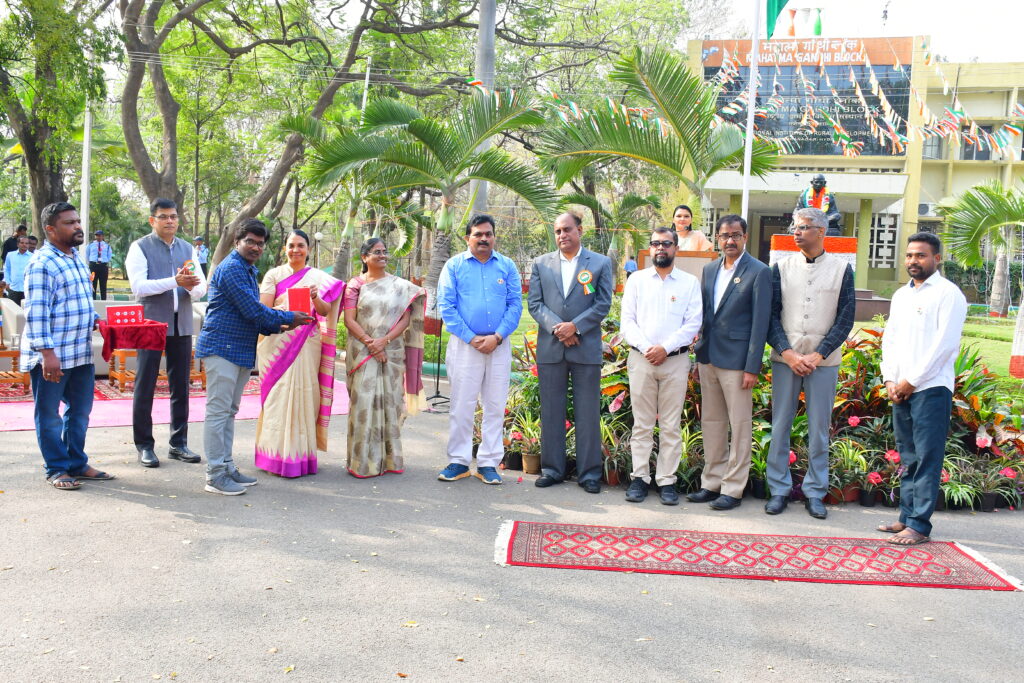
CONTENTS:
LEAD STORY: Indigenous Model of Flexi Water Tube Level for Levelling Operations in Rural Development
NIRDPR Celebrates 75th Republic Day
NBA and NIRDPR Organise International Convention of Wetlands and Biodiversity
CICT, OL Section (CDC) Jointly Organise Training on Google Bard
5th Management Development Programme on Rural Development Leadership for BDOs
How SHGs Improved the Economic Condition of Rural Women? A Study in Jorhat District of Assam, India
International Training Programme for Elected Representatives of the Republic of Maldives
UBA Cell, NIRDPR Conducts Mission LiFE Programme at SNVPMV, Hyderabad
Aspiring to Make a Poverty-Free Panchayat: The Story of Jharnipali Gram Panchayat in Odisha
Hindi Workshop on Unicode Organised at NIRDPR
NIRDPR Official Attends Regional Official Language Conference
Training Programme on Development of Managerial Skills for Fishery Officers from Odisha
NIRDPR Observes Mahaparinirvan Diwas
LEAD STORY:
Indigenous Model of Flexi Water Tube Level for Levelling Operations in Rural Development
Er. H. K. Solanki
Assistant Professor (Sr. Scale), Centre for Rural Infrastructure, NIRDPR
hksolanki.nird@gov.in
Background and Introduction
Level apparatus is one of the most regularly used apparatus by both technical and non-technical users in rural and urban sectors. For instance, professionals use level apparatus for precision levelling, while farmers and field engineers use the same for field levelling, layout and alignment of bunds, buildings, roads, drainages, and irrigation channels. There are several techniques to determine reduced levels or elevations and the elevation differences. Major levels used for direct or spirit levelling in plane surveying are Dumpy level, Wye (or Y) level, Reversible level, Tilting level, Precise levels, Automatic or auto set level, Theodolite, Transit, Total station, and GPS. These methods are expensive, instruments are bulky and require intensive training to use. Other apparatus used for levelling are boning roads, N-frame level, flexible tube water level, and hand level. These survey methods are described by Punmia et al., (2005), Michael & Ojha (2005), Sharda et al. (2007) and other eminent authors about the working principles of these instruments.
The details of this apparatus and its operations (basic) can be found in the Food and Agricultural Organisation (FAO, 1985) document, in which the instrument has been used and described first time. Later it was cited in other books and manuals of Tideman, E.M. (1996) and ILO (1915).
The instrument has been used by Samaj Pragati Sahayog and described in their Video on Ridge Area Treatment under Watershed Development (Samaj Pragati Sahayog, 2007)
In spirit levels, in general, we depend first on the surface of the water in circular or tubular bubble spirit levels to adjust the apparatus horizontally, and next, we depend on seeing through the horizontal line of sight from the apparatus. It comprises one level apparatus handled by a level man and one or more staff handling the staff(s). The staff are also of two kinds, one as self-reading type where the level man takes reading by seeing the staff from the level eyepiece, and another as target staff where the reading on staff is taken by staff man.
In the case of instruments using water or fluid levels, if two arms of a tube remain far, the liquid level would be the same at both open ends of the tube. That is, a line drawn between the upper surfaces of the liquid two arms would be “level”. For simplicity and clarity in this discussion “level” will be understood in the simple sense that each point on the upper surface of an interconnected still pool of liquid is “level” with respect to each other. In other words, the free water surfaces in the tube ends have the same levels based on the principle of ‘communicating vessels’. This becomes possible because of equal atmospheric pressure and temperature on both open ends of the tube in short distances.
The spirit levels or auto levels are costly. These are not easy to use and adjust. At least one fully skilled and trained person is required to operate the apparatus. Mostly four-wheelers are required to transport the apparatus to the site of operation. Frequent uses are difficult and tiring.
In spirit levels, the accuracy depends on horizontal adjustment and levelling of level instruments such that any minute mistake in horizontal adjustment can result in large errors in long sights. Further, the spirit levels cannot be used in the dark or in case of obstacles hindering the line of sight.
To overcome the problems faced in the existing systems, the Flexi water tube level method based on the equal height of water level surfaces in interconnected fluids, which involves low cost, in its basic form is described here. The further modifications are also cheaper than spirit levels. It is easy to use and understand with little training. The present apparatus uses this technique for various level operations such as differential and profile levelling as well as for small-scale topographical surveying.
The technique is being used by masons in many ways during construction works in its rudimentary manner. The method is mostly used for level difference between two points, layout of contours or calculation of slopes.
The instrument is described in the literature as mentioned above, however, the instrument with advanced methods of operations and modifications as described in further sections has been filed for patent also (patent application number 202241044291, published in the official journal of the patent office, issue number 33/2022) (Solanki, H.K., 2022). The pictures of the instrument are depicted below sections.
Components and Construction
In this article, the basic form of apparatus has been described everywhere from construction to use, which can be constructed locally with generally available material in the local markets. Further embodiments which require industrial application are not described.
The apparatus includes the following parts as shown in Figure 1.
- Two graduated solid staffs made of wood, metal, plastic, fibre, PVC or any other material of circular, square or any other convenient shape,
- Both the staffs should be equally scaled, having equal manually operable heights suitable to read by an average human (of about 1.80 to 2.0 metres)
- Having painted, pasted or engraved graduations in English or metric units, of least count up to 1 mm or as per required survey precision. Proper graduations can be marked by a permanent marker up to centimetre or mm level as per convenience.
- The portion of staff length touching the ground may be conical and solid and may be capped with tough metal or material for lessening the wear and tear of the ground touching portion. However, it is not a restriction to have a conical capped with metal, but advantageous to reduce wear in frequent uses.
- One ordinary water bottle with a capacity of about half litre to 1 litre and more as per the quantum of survey and possible requirement of change of water due to spillage and air bubbles, etc., during the survey.

Figure 1: Components of apparatus in its basic form.
- The plurality of small and thin plastic/fibre/metal round or square plates, hard paper/cards or lime or other kinds of powder, or wooden pegs for marking survey points on the ground.
- A transparent flexible tube of variable lengths as per the survey requirement and feasibility of verbal communications (preferably within 30 metres of length for proper handling of a filled tube), having a diameter of about 1.0 centimetre. Locally available as generally used by masons.
- During survey/levelling operations, the tube will remain filled with water or any other viscous fluid as per the requirement of the survey. As normal water is easily and freely available, the further sections will describe using water only.
- A measuring tape of about 30 metres, out of which the lengths may be used as per requirements for measuring the chainage.
- Manpower of 2 to 3 semiskilled persons is sufficient to operate this apparatus.
- A notebook and a pen for taking the readings in the manner described in further sections.
The Method of Construction of Apparatus in Its Initial and Simple Form:
The method of construction of the apparatus in its initial form is simple and can be done at the home/hamlet level.
First, two flat wooden (other kinds of material like PVC/fibre can be tried in a later phase) strips of the length of about 5.5-6 feet, width or 1.5-2 inches and depth of about ½ inch can be purchased from a local carpenter. These are available with them as scrap material also. Wood should be seasoned to avoid warping with dryness in future. Their one side should be perfectly flat. Other sides can also be smoothened by local carpenter.
These staffs can be marked with black permanent marker in perfect equal matching scale on both the staffs. The least count can be kept one centimetre or half a centimetre on both the staffs. When marking one side (starting of marking) should be kept against a horizontal line to check in between and also that the marking on both staff are perfectly matching on each staff. Not caring for this properly will result in continuous errors in all readings.
A transparent tube of 20-30 metres of about 1-centimetre outer diameter which masons use in their day-to-day work is to be purchased from the local market.
A few paper pieces/cardboard pieces/plastic plates/lime powder or wooden pegs can be used to mark the points on the ground. It will be better if centre points are marked or scribed.
A water bottle can be taken as available everywhere.
And your apparatus is ready to use and run on the ground.
Techniques of using the apparatus for differential, profile and topographical surveys, with a few examples of practical applications are described in further sections.
Method of Operation in Detail
Figures 2 and 3 provide the schematic of the technique and working principle of the apparatus for taking elevations or reduced levels, and relative differences in elevations under differential, profile and topographical surveying operations. As depicted in Figure 2 the tube ends are kept open. The survey requires two staff holding persons called the back man and the front man. The one staff person called back man holds the staff vertically on the top of the first point and attaches one end of water filled tube with his staff called back staff. The other staff person called the front man has a second staff and the other end of water filled tube moves forward on the selected survey line in the traverse direction, selects a point to place the staff and holds the staff vertically on it. To identify and mark the points, the back man and front man put small and thin plastic/fibre/metal round or square plates, or hard paper/cards or lime or other kinds of powder or wooden pegs. Cross marks can be provided on the plates by scribers to increase the precision and proper identification of survey points.
Note: All readings in further sections are in metres.


After settling down the water in the tube at both ends when no oscillation is there, the readings corresponding to the water level are taken at both ends by the back man and front man keeping the site of the eye as much perpendicular to the tube and in line with water level as possible. The staff are to be kept perfectly vertical by visual adjustment. These sets of readings from back staff and front staff are considered for one setup. In the example mentioned and shown in Figure 3 the setup is changed four times and corresponding readings are entered in Table 1 by the prevailing method for taking the level difference between two points A and E on the ground. Here points B, C and D are called turning points (TP) as the water level is changing at these points with changed setup as per natural settling of water level in each setup. These details are mentioned in a further section also for the same readings and setups. When the setup is changed both open ends of water tubes are to be kept closed during movement by both back and front man to avoid spillage of water. These are to be opened again when used for taking reading again in the next setup.
Table 1: The level difference between two points for example of Figure 3
| Between pegs/points (pairs) | Back Reading | Front Reading |
| A and B | 0.65 | 1.64 |
| B and C | 0.45 | 1.56 |
| C and D | 0.74 | 1.72 |
| D and E | 0.38 | 1.48 |
| Total | 2.22 | 6.40 |
| The elevation difference between points A and E is the sum of back readings minus the sum of front readings which is 2.22-6.40 = -4.18 metres (minus indicates the fall) | ||
| The purpose is to get the elevation difference between two points |
The booking or tabulation of readings shown in Table 1 can be used only for the difference in elevations between two points; however, the following tabulation in Table 2 for the same readings is an inventive step to enter the readings for getting the elevations of each point along with a difference in elevation of points. For that, the first reading point is to be assumed at a temporary or arbitrary benchmark with an imaginary level of 100 metres generally. The entry of readings in a revised and improved way to know the profile of elevation for each point is shown in Table 2.
This tabulation for finding the reduced level can be called a collimation or height of water level method, and can be extended to the rise and fall method also by adding a column as rise/fall. The chainage column also can be added to get chainage distances between points.
Table 2: Reducing Levels from the Height of Water Level Method for Example of Figure 3
| Name of point | Back Reading | Front Reading | Elevation/Reduced level | Height of water level |
| A | 0.65 | 100 | 100.65 | |
| B | 0.45 | 1.64 | 99.01 | 99.46 |
| C | 0.74 | 1.56 | 97.9 | 98.64 |
| D | 0.38 | 1.72 | 96.92 | 97.30 |
| E | 1.48 | 95.82 | ||
| Total | 2.22 | 6.40 | 100-95.82=4.18 | |
| The elevation difference between points A and E is the sum of back readings minus the sum of front readings and elevation of the first point minus elevation of the last point | ||||
| The purpose is to get the elevation of each point with reference to a benchmark. |
Here, the height of the water level can be considered similar to the concept of the height of the instrument in spirit levels and the changed height of water levels at turning points can be considered similar to the concept of the changed height of the instrument in spirit levels. This similarity concept is being quoted here for reference of a person known to survey principles using spirit levels. In this way, it is established that the working methods of this apparatus are at par with the spirit levels of operational efficiency and simplicity especially for shorter chainage distances.
The following formula or method has been applied to know the height of water levels and reduced levels/elevations of points.
Formula 1: Height of water level = Reduced level + Back reading
Formula 2: Reduced level = Height of water level – Front reading
Here, the back reading is the reading of the water level in the tube against staff standing at the point of known elevation started from a temporary benchmark and the front reading is the reading of the water level in the tube against staff standing at the point of unknown elevation. So, all the back-person readings will be back readings and front-person readings will be front readings.
Regarding Figure 3 and Table 2, at point A, the back reading of 0.65 metres is added to 100 metres of assumed elevation of the temporary benchmark at point A, and the height of water level (HW) is calculated by using formula 1 as 100+0.65=100.65 metres. The reduced level for point B is found by reducing the front reading of point B from the height of the water level, by using formula 2 as 100.65-1.64 = 99.01 metres. Now, the setup is changed between points B and C, where the back man with a back staff and one end of the tube, standing previously at point A will move forward to point B and put his staff at point B and the front man with a front staff and one end of tube who was previously standing at point B will move to point C. After settling down the water in the tube, both the back man and front man will read their staff reading matching the water level in the tube. The reading at point B will be the back reading of point B as now the elevation or reduced level of point B is known as 99.01 metres. Reading at staff C will be front reading at point C. As per previously used formula 1, the height of the water level for this setup is reduced level at point B plus the back reading at point B comes to 99.01+0.45=99.46 metres. The reduced level of point C from formula 2 is the height of the water level at point B minus the front reading at point C comes to 99.46-1.56=97.90 metres. The setup is moved between points C and D now where the back man at point B will move and place staff exactly at point C and the front man will move further and place his front staff at new point D. The reading at point C will be the back reading of point C as elevation is known for the point C now and reading at point D will be the front reading as elevation is unknown, and the same procedure is repeated, and survey can continue further. Finally, this method of use and tabulation will give reduced levels or elevations of each point with chainages and level differences between points as mentioned in Table 2.
The above method of use of apparatus is based on the natural setting of water level in each setup and each time the reading at back staff is back reading and for each setup new height of water level is calculated.
Using the rise and fall method in addition or as an alternative to the height of water level method
In this method, we can add one more column in the table for Rise/Fall which is the difference between back reading and front reading.
Formula 3: Rise/Fall= Back reading at previous point – front reading at next point
This may come in + (plus) or – (minus) sign both, where minus indicates the fall downwards on the slope, and plus indicates the rise upwards on the slope. If it is in minus, it is to be reduced from the reduced level of the previous point as we are going downwards in elevation. If it is coming positive or plus, then it is to be added in a reduced level of elevation of the previous point as we are moving upwards. In this way, the reduced level or elevation of the next point, where the front reading has been taken will come. The process will be repeated to get the elevation of the next points in a similar way for a complete survey.
This has been described for the same readings as taken from Figure 3 and by adding one more column in Table 2. If we are using the Rise and Fall method, then the height of the water level column from the table can be removed also. The table is revised in the following manner by including the rise and fall column and adding and reducing the rise and fall values (plus or minus) from the elevation of the previous point. If we match Table 2 with Table 3, we will find that the reduced levels of the points are the same in Tables 2 and 3. Hence, any method may be used by the user which he/she finds convenient.
Table 3: Reducing Levels from the Rise and Fall Method for Example of Figure 3
| Name of point | Back Reading | Front Reading | Rise/Fall (+/-) | Elevation/Reduced level |
| A | 0.65 | 100 | ||
| B | 0.45 | 1.64 | 0.65-1.64= -0.99 | 100-0.99 = 99.01 |
| C | 0.74 | 1.56 | 0.45-1.56= -1.11 | 99.01-1.11 = 97.9 |
| D | 0.38 | 1.72 | 0.74-1.72= -0.98 | 97.90-0.98 = 96.92 |
| E | 1.48 | 0.38-1.48= -1.1 | 96.92-1.1 = 95.82 | |
| Total elevation difference = elevation of first point minus elevation of last point | 100-95.82=4.18 |
Field Application Examples
The instrument was tested rigorously for water harvesting structures, roads and building works at various places and in rural setups with semiskilled or unskilled rural workers. A few cases are described below.
Case 1: Reduced levels for proposed water harvesting structures
The first set of levels was measured for a community pond in Village, Badgaon, Block Sheoganj, District Sirohi, Rajasthan. A set of 33 observations were taken in the proposed bund length of 495m, which took about 40 minutes to complete the task. The reduced levels ranged from 99.02 m to 100.28 m. The readings are shown in Table 4.
Table 4: Readings with Flexi Tube Level for a Water Harvesting Structure, a Village Community Pond
(All readings in metres)
| Chain | BR | IR | FR | HW | Rise | Fall | RL | Remarks/ Station |
| 0 | 1.0 | 101.0 | 100 | BM | ||||
| 15 | 1.01 | 101.0 | 0.01 | 99.99 | ||||
| 30 | 1.04 | 101.0 | 0.03 | 99.96 | ||||
| 45 | 1.11 | 101.0 | 0.07 | 99.89 | ||||
| 60 | 1.18 | 101.0 | 0.07 | 99.82 | ||||
| 75 | 1.25 | 101.0 | 0.07 | 99.75 | ||||
| 90 | 1.32 | 101.0 | 0.07 | 99.68 | ||||
| 105 | 1.42 | 101.0 | 0.10 | 99.58 | ||||
| 120 | 1.00 | 1.52 | 100.48 | 0.10 | 99.48 | Turning point | ||
| 135 | 1.07 | 100.48 | 0.07 | 99.41 | ||||
| 150 | 1.15 | 100.48 | 0.08 | 99.33 | ||||
| 165 | 1.2 | 100.48 | 0.05 | 99.28 | ||||
| 180 | 1.27 | 100.48 | 0.07 | 99.21 | ||||
| 195 | 1.37 | 100.48 | 0.10 | 99.11 | ||||
| 210 | 1.49 | 100.48 | 0.12 | 98.99 | ||||
| 225 | 1.46 | 100.48 | 0.03 | 99.02 | ||||
| 240 | 1.38 | 100.48 | 0.08 | 99.10 | ||||
| 255 | 1.23 | 100.48 | 0.15 | 99.25 | ||||
| 270 | 1.16 | 100.48 | 0.07 | 99.32 | ||||
| 285 | 1.08 | 100.48 | 0.08 | 99.40 | ||||
| 300 | 1.03 | 100.48 | 0.05 | 99.45 | ||||
| 315 | 0.91 | 100.48 | 0.12 | 99.57 | ||||
| 330 | 0.8 | 100.48 | 0.11 | 99.68 | ||||
| 345 | 0.75 | 100.48 | 0.05 | 99.73 | ||||
| 360 | 0.71 | 100.48 | 0.04 | 99.77 | ||||
| 375 | 0.71 | 100.48 | 0.00 | 99.77 | ||||
| 390 | 0.84 | 100.48 | 0.13 | 99.64 | ||||
| 405 | 0.85 | 100.48 | 0.01 | 99.63 | ||||
| 420 | 0.71 | 100.48 | 0.14 | 99.77 | ||||
| 435 | 0.63 | 100.48 | 0.08 | 99.85 | ||||
| 450 | 0.62 | 100.48 | 0.01 | 99.86 | ||||
| 465 | 0.50 | 100.48 | 0.12 | 99.98 | ||||
| 480 | 0.35 | 100.48 | 0.15 | 100.13 | ||||
| 495 | 0.20 | 100.48 | 0.15 | 100.28 | ||||
| Sum ∑ | 2.0 | 1.72 | 1.43 | 1.15 |
In Table 4, the data is entered in both noting systems i.e. collimation or height of water level method and the rise and fall method so the note checks or arithmetic checks on the accuracy of data can be performed by both methods, first as:
׀ ∑ FR – ∑ BR ׀ = ׀ Δ Elevation ׀
i.e. the absolute value of the sum of the front readings minus the sum of the back readings should equal the absolute value of the difference (Δ) in beginning and closure elevation, and second as:
׀ ∑ FR – ∑ BR ׀ = ׀ ∑ Rise – ∑ Fall ׀
i.e. the absolute value of the sum of the front readings minus the sum of the back readings should equal the absolute value of the sum of rises minus the sum of falls.

In profile levelling, as in the case in Table 4, in the rise and fall method, all the readings are checked for note accuracy.
The result of both the tests for the readings of Table 3.
׀ ∑ FR – ∑ BR ׀ = ׀ Δ Elevation ׀
׀ 2.0 – 1.72 ׀ = ׀ 100.28 – 100.0 ׀
0.28 = 0.28
Similarly:
∑ FR – ∑ BR ׀ = ׀ ∑ Rise – ∑ Fall ׀
׀ 2.0 – 1.72 ׀ = ׀ 1.43 – 1.15 ׀
0.28 = 0.28
On both tests, the data are correct so the notes have no arithmetic error in Table 4.
Case 2: Reduced levels for a building by taking the difference between the first floor and porch
Another set of elevations was generated by surveying the levels on the first floor and porch of the State Head Quarter Building of the Agriculture Department of Government of Rajasthan State by stepping down on stairs (Table 5). The entire exercise took place within about 10 minutes with a total of two persons and the difference between elevations of the first floor and porch level was found as 4.36 metres.
Table 5: Readings to find the difference between the first floor level and porch level of the State Agriculture Building, Jaipur, Rajasthan, with the help of Flexi Water Tube Level
(Readings in metres)
| S. No. of readings | BR | HW | FR | Elevation/Reduced levels | Station | Remark |
| 1 | 0.50 | 100.50 | 100.0 (A) | BM | Start point/first floor | |
| 2 | 0.20 | 99.09 | 1.61 | 98.89 | TP1 | Second point(turning point) some stairs below |
| 3 | 0.20 | 97.73 | 1.56 | 97.53 | TP2 | Third point (turning point) some more stairs below |
| 4 | 0.50 | 97.20 | 1.03 | 96.70 | TP3 | Fourth point (turning point) at the ground floor |
| 5 | 1.56 | 95.64 (B) | The last point at the porch level | |||
| Sum ∑ | 1.40 | 5.76 | ||||
| So, the difference between the floor level of the first floor and porch can be easily calculated as A – B = 100 – 95.64 = 4.36 metres. Readings could also be taken in millimetres if graduated so on sticks. |
All back readings (BRs) and front readings (FRs) are counted in this case, so no need to check with the rise and fall method.
׀ ∑ FR – ∑ BR ׀ = ׀ Δ Elevation ׀
׀ 5.76 – 1.40 ׀ = ׀ 100.00 – 95.64 ׀
4.36 = 4.36
No difference in the readings verifies the accuracy of the apparatus and its applicability in different layouts.
Case 3: Reduced levels for a bitumen road
Apparatus was tested for error of closure (in which the last reading is taken on the starting (first) point and the difference in elevation of both readings is called an error of closure) at a road. It was a bitumen road of 315 metres on the campus of Birla Institute of Scientific Research, Jaipur, Rajasthan (Table 6). The error of closure was found as 10 mm.
Table 6: Readings with Flexi Tube Level on bitumen road at Birla Auditorium Campus in Jaipur (to check the error of closure)
(All readings in metres)
| Chain | BR | IR | FR | HW | RL | Remarks/ Station |
| 0 | 1.000 | 101.00 | 100.000 | BM | ||
| 15 | 1.305 | 101.00 | 99.695 | |||
| 30 | 1.325 | 101.00 | 99.675 | |||
| 45 | 1.220 | 101.00 | 99.780 | |||
| 60 | 1.120 | 101.00 | 99.880 | |||
| 75 | 1.035 | 101.00 | 99.965 | |||
| 90 | 1.060 | 101.00 | 99.940 | |||
| 105 | 1.095 | 101.00 | 99.905 | |||
| 120 | 1.115 | 101.00 | 99.885 | |||
| 135 | 1.135 | 101.00 | 99.865 | |||
| 150 | 1.160 | 101.00 | 99.840 | |||
| 165 | 1.150 | 101.00 | 99.850 | |||
| 180 | 1.120 | 101.00 | 99.880 | |||
| 195 | 1.130 | 101.00 | 99.870 | |||
| 210 | 1.125 | 101.00 | 99.875 | |||
| 225 | 1.120 | 101.00 | 99.880 | |||
| 240 | 1.180 | 101.00 | 99.820 | |||
| 255 | 1.230 | 101.00 | 99.770 | |||
| 270 | 1.275 | 101.00 | 99.725 | |||
| 285 | 1.350 | 101.00 | 99.650 | |||
| 300 | 1.325 | 101.00 | 99.675 | |||
| 315 | 1.010 | 101.00 | 99.990 | BM |
The error of closure is 100.00 – 99.99 = 0.01 metre or 10 mm in the run of 315 metres.
For most of the engineering surveys, the permissible error of closure of a level circuit in mm is 24mm√K where K is the distance in kilometres. The apparatus error found was 10 mm which is less than the permissible limit. However, further experimentations are required for error of closure of the apparatus for various number of setups for proper correlation and regression analysis.
Case 4: Reduced levels for a percolation tank to construct a diversion drain on one side of the structure
On a percolation tank in NIRDPR to increase the catchment area it was planned to construct a diversion drain to fetch the water which was not coming to the tank previously. For this, it was planned to take levels of the bund of tank along with some distance on the upper side of the bund and till the start point of the diversion drain meeting one side of the bund.
A total of 34 points were taken with mostly 10 metres of chainage distances. The total cumulative length of the survey was 307 metres. The data and reduced levels are shown in Table 7. The graph of cumulative distance versus reduced levels is shown in Figure 5.
Table 7: Levels of Percolation Tank Near H Type Quarters in NIRDPR, Taken with Flexi Water Tube Level
| Point No. | chainage | cumulative distance | back reading | front reading | Rise/ Fall (+/-) | GL With Rise and Fall | G.L. with height of water level | W.L | Remark |
| 1 | 0 | 0 | 0.05 | 100 | 100.05 | TBM at Security Guard Room | |||
| 2 | 2 | 2 | 1.67 | 0.87 | -0.82 | 99.18 | 99.18 | 100.85 | |
| 3 | 10 | 12 | 0.23 | 1.49 | 0.18 | 99.36 | 99.36 | 99.59 | |
| 4 | 10 | 22 | 0.04 | 1.39 | -1.16 | 98.2 | 98.2 | 98.24 | |
| 5 | 10 | 32 | 0.55 | 1.54 | -1.5 | 96.7 | 96.7 | 97.25 | |
| 6 | 10 | 42 | 0.91 | 1.32 | -0.77 | 95.93 | 95.93 | 96.84 | |
| 7 | 10 | 52 | 0.74 | 1.07 | -0.16 | 95.77 | 95.77 | 96.51 | |
| 8 | 10 | 62 | 0.82 | 1.12 | -0.38 | 95.39 | 95.39 | 96.21 | |
| 9 | 10 | 72 | 0.5 | 1.09 | -0.27 | 95.12 | 95.12 | 95.62 | |
| 10 | 10 | 82 | 0.6 | 1.25 | -0.75 | 94.37 | 94.37 | 94.97 | |
| 11 | 10 | 92 | 0.57 | 1.31 | -0.71 | 93.66 | 93.66 | 94.23 | |
| 12 | 10 | 102 | 0.53 | 1.36 | -0.79 | 92.87 | 92.87 | 93.4 | |
| 13 | 10 | 112 | 0.48 | 1.3 | -0.77 | 92.1 | 92.1 | 92.58 | |
| 14 | 10 | 122 | 1.07 | 1.34 | -0.86 | 91.24 | 91.24 | 92.31 | |
| 15 | 10 | 132 | 0.92 | 1.05 | 0.02 | 91.26 | 91.26 | 92.18 | |
| 16 | 10 | 142 | 0.91 | 1.15 | -0.23 | 91.03 | 91.03 | 91.94 | |
| 17 | 10 | 152 | 1.04 | 1.17 | -0.26 | 90.77 | 90.77 | 91.81 | |
| 18 | 10 | 162 | 0.98 | 1.04 | 0 | 90.77 | 90.77 | 91.75 | |
| 19 | 10 | 172 | 0.7 | 1.07 | -0.09 | 90.68 | 90.68 | 91.38 | |
| 20 | 10 | 182 | 0.9 | 1.26 | -0.56 | 90.12 | 90.12 | 91.02 | |
| 21 | 10 | 192 | 0.92 | 1.17 | -0.27 | 89.85 | 89.85 | 90.77 | |
| 22 | 10 | 202 | 1.05 | 1.025 | -0.105 | 89.745 | 89.745 | 90.795 | |
| 23 | 10 | 212 | 1.13 | 0.97 | 0.08 | 89.825 | 89.825 | 90.955 | |
| 24 | 10 | 222 | 0.99 | 0.88 | 0.25 | 90.075 | 90.075 | 91.065 | |
| 25 | 10 | 232 | 1.08 | 0.92 | 0.07 | 90.145 | 90.145 | 91.225 | |
| 26 | 10 | 242 | 0.22 | 0.58 | 0.5 | 90.645 | 90.645 | 90.865 | |
| 27 | 7 | 249 | 1.55 | 1.52 | -1.3 | 89.345 | 89.345 | 90.895 | Sluice Centre |
| 28 | 3 | 252 | 1.25 | 0.39 | 1.16 | 90.505 | 90.505 | 91.755 | |
| 29 | 10 | 262 | 0.3 | 0.78 | 0.47 | 90.975 | 90.975 | 91.275 | |
| 30 | 5 | 267 | 0.83 | 1.14 | -0.84 | 90.135 | 90.135 | 90.965 | |
| 31 | 10 | 277 | 0.85 | 1.03 | -0.2 | 89.935 | 89.935 | 90.785 | |
| 32 | 10 | 287 | 0.79 | 0.99 | -0.14 | 89.795 | 89.795 | 90.585 | |
| 33 | 10 | 297 | 0.94 | 0.86 | -0.07 | 89.725 | 89.725 | 90.665 | |
| 34 | 10 | 307 | 0.84 | 0.1 | 89.825 | 89.825 |

Various Advantages of Using Flexi Tube Level
Reduced weather impacts: In other apparatus like spirit levels, any obstacle or hindrance like rain, wall or anything which can affect the line of sight or apparatus’s lenses like water droplets or dust, etc., can affect the method because these apparatuses mostly depend on the visibility of staffs from a large distance and exact horizontal adjustment of line of sight in apparatus. In this apparatus, we need to see reading from about 1.0 to 1.5 feet only with both eyes open so the method of taking reading is not hindered by any obstacle, rain, or darkness.
Least stress on eyes: We can work with both eyes open and consequently less stress on the eyes.
Can measure across the opaque objects: We can pass on the tube from windows, doors, holes, etc., and can move up/down and turn with the apparatus on the stairs by taking levels from the apparatus. For the wall between readings, we can search for holes in it or create a hole in it to pass the tube.
Work in less illumination or even in the dark: It can be used in the dark with the help of a torch or mobile phone, and also, when there may be an opaque environment or bushes or walls in between the two ends of the tube. Only the passage up to the tube diameter is required for easy passage of the tube.
No horizontal adjustment required: Minute angular variations in the horizontal adjustment of spirit levels can create large reading differences/variations with increased distances of staff from the level instrument, as per the trigonometry. In the Flexi tube level, seeing through a horizontal line of sight has been omitted. The height of water level at two different interconnected points is seen independently, so the need for a level apparatus to see the staff through the line of sight is omitted. As a consequence, errors related to the horizontal adjustment of apparatus, line of sight, earth curvature and refraction are omitted. However, the staff should be kept in a vertical position without tilting, in the best possible ways.
Similar manpower efficiency required: Both the staff men can have almost equal efficiency levels. While in spirit levels at least one person should be well trained in survey operations.
Lighter in weight and easy to transfer: In the form described in this manual, the tube is not clamped or fixed with staff and can be handled separately in a small bag also and staff can be kept in a separate casing or hands, which makes the instruments handy, easily constructible at village/home level and versatile. total weight can be remained near about 2-3 kilograms.
Cheap and easy to construct/operate: In its initial and basic form, it is cheap and easy to construct/operate. This is an effective advantage in developing countries like India.
Possibility to have intermediate readings: Handling the tube and staff separately in a free manner gives the chance to control the height of the water level in the tube at desired levels. In other words, assuming and maintaining the back sight reading as per our convenience and making the water level in the tube remain on this reading on the back staff side, other intermediate readings come automatically matching with this height of water level. This phenomenon gives a chance to use the apparatus to take many Intermediate readings also, instead of only back and front readings.
Can be used frequently: It can be used more frequently on-site by matching the pace of the work, in comparison to spirit levels.
Limitations
As an adjustment, the apparatus requires exact and careful matching of water levels with staff scale and carefully taken readings.
Length of run or grid interval generally can be taken for PVC tube as 20-30m only, more than this may create difficulty in handling a tube filled with water.
The occurrence of air bubbles is due to mishandling or frequent use; change/refill of water can overcome this problem.
For a given apparatus and atmospheric conditions, the precision depends upon the number of setups or shift of apparatus and this apparatus has the setups changed for N-1 times where N is the number of points on the ground, where readings are taken. This can be minimised by having the length of the tube as much as possible matching with the handling of tube filled with water.
The use of good quality precisely marked staff and the use of thin & hard steel, paper or plastic plates below the staff, or wooden pegs can reduce the error of closure of this apparatus.
In one setup the height difference between two points should not be beyond the workable height of staff. If so, the horizontal distance of the two points can be reduced appropriately.
This apparatus is difficult to use in very dense, thorny, hard bushes where human movement is hindered.
The equation for permissible closing error can be expressed as E’=C’√K where E’= permissible closing error in mm; C’= constant; and K = distance in km. However, for this instrument, the research experiment is required to establish a proper correlation and regression between the number of setups and the error of closure.
General Applications of Apparatus
This apparatus is comparable to dumpy level and other high precision level apparatus also, with some limitations. Adding its other qualities such as being easy to construct, learn, operate, carry and cheaper in its category, it becomes non-comparable in its kind.
This apparatus gives an economic and precise method for finding levels and to calculate differences in elevation. The cost of this apparatus is far less than the cost of other levelling instruments. For normal and small survey works, where the best combination of cost, accuracy, easy transportability and operation will be required, this apparatus is a feasible option.
It is so easy to use apparatus, that an ordinary person with simple onsite training can use it. It provides the technicians with an easy-to-handle and learn apparatus by which they can maintain the quality of their work matching the pace of work.
The apparatus can be successfully used for the following sectors/areas (but not limited to), especially for rural development and rural infrastructure:
- To make contour lines/contour maps
- Need-based small-area topographical surveys
- To check and maintain top levels of bunds
- Providing layout of the bunds, irrigation channels
- To measure the height of bunds or the difference between the vertical height of two points
- To get an L-Section and cross-section of the drainage line
- To check and maintain levels, giving layouts, cross-sectioning of roads/rural drainages
- To check the levels of building works/projects at various construction stages
- Various agricultural surveys
The following photos depict the actual use of apparatus in the field.

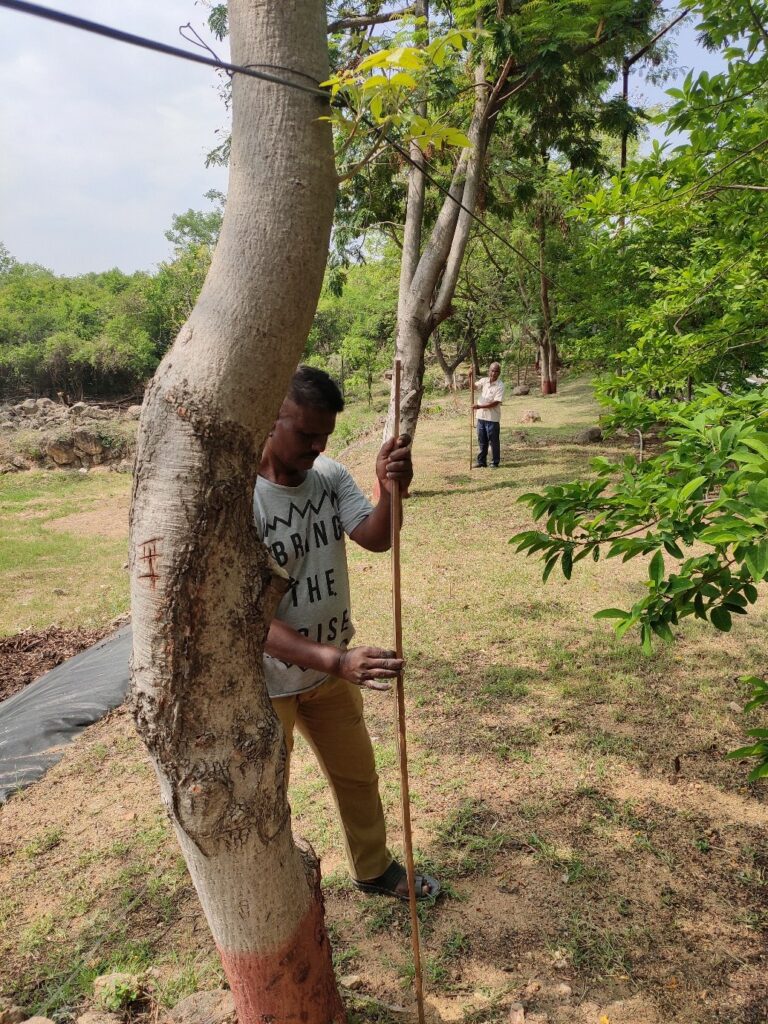
NIRDPR Celebrates 75th Republic Day
The National Institute of Rural Development and Panchayati Raj, Hyderabad celebrated 75th Republic Day with all its fervour on 26th January 2024.
Dr G. Narendra Kumar, IAS, Director General, NIRDPR was the Chief Guest of the occasion. The Director General hoisted the National Flag, and it was followed by a march past by the Security wing of the Institute.
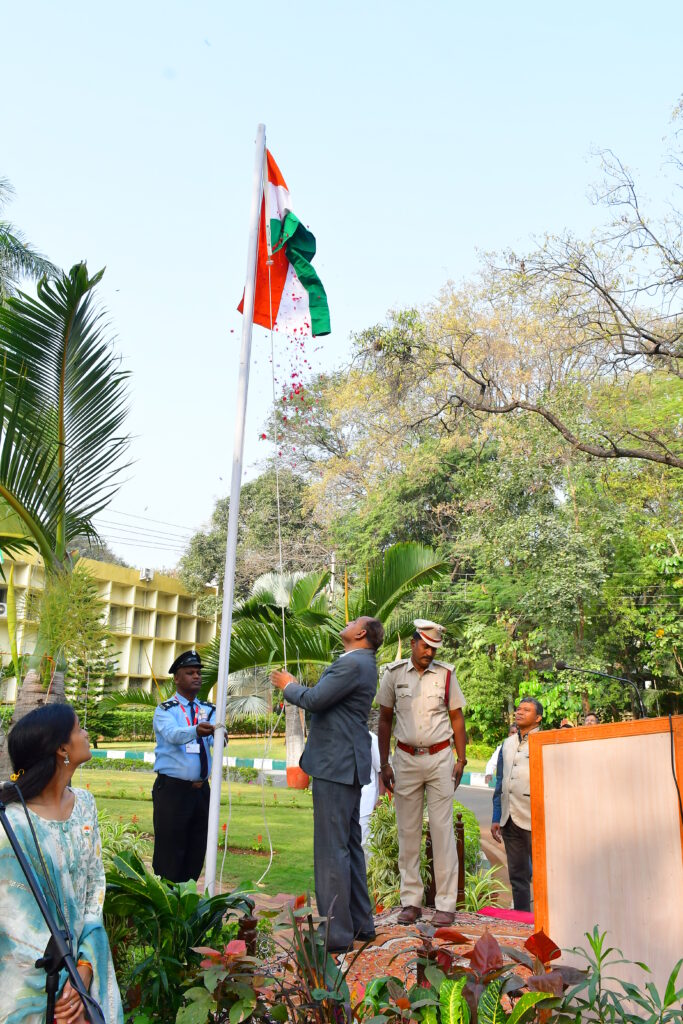
In his Republic Day address, the Director General extended the greetings of the occasion to faculty, staff, students and participants, especially elected representatives from Maldives.
“The 75th Republic Day is very significant in the progress of the country in making commitments towards a Viksit Bharat by 2047, which marks 100 years of our independence. It also recognizes the spirit of democracy that has enlightened, strengthened, and developed this country,” he said.
Recalling his association with NIRDPR as its Director General, Dr G. Narendra Kumar said the journey with the Institute has been very significant and momentous in taking the country forward towards development. Further, mentioning the role played by NIRDPR in the Aspirational Blocks Programme, he thanked all those who have contributed to the expansion of the Institute’s activities with quality. The DG further made a brief note of the recent significant achievements of the Institute.
“As part of the Aspirational Blocks Programme, NIRDPR hosted a number of leadership courses for Block level officers, which played a pivotal role in changing the status of their blocks. To further handhold them, we developed sectoral modules in nine different sectors and validated the modules through workshops involving experts. These modules are ready for dissemination among Block level officers in a short while. Our efforts are recognized at the highest levels. During the launch of Aspirational Blocks Sankalp Saptaah, Dr Anuradha Pallah, Assistant Professor met the Hon’ble Prime Minister and apprised him of the good work done by NIRDPR to take the Aspirational Blocks forward,” he said.
“We also organised a special event to mark 30 years of Panchayati Raj Institutions after the Constitutional Amendments to make them true local governments. We held stakeholder workshops across a spectrum of stakeholders on a number of themes simultaneously to chart out the course for the good functioning of these democratic institutions on the path to progress towards Viksit Bharat,” the DG added.
Dr G. Narendra Kumar further exhorted everyone to come together to develop significant knowledge to take India on the path of progress towards a Viksit Bharat by 2047 by effectively applying the knowledge that we have developed through various capacity-building programmes and training programmes for the benefit of poor and downtrodden in this country and our partner countries all over the world.
The Director General also released the NIRDPR Calendar for the year 2024 on this occasion.
Further, Dr Anjan Kumar Bhanja, Associate Professor & Head, CPRDP&SSD, NIRDPR gave a brief address on the training programmes conducted by NIRDPR for elected representatives of Island Councils of the Republic of Maldives. The Director General honoured the elected representatives with a memento.
The Director General along with Shri Manoj Kumar Registrar & Director (Admin), Shri A. S. Chakravarthy, Director (Finance) and senior faculty members, distributed prizes to the winners of various sports competitions organised by the Sports & Recreation Club of NIRDPR as part of the Republic Day celebrations.
PHOTO GALLERY:
Please find below the video footage of the event:
NBA and NIRDPR Organise International Convention of Wetlands and Biodiversity
The National Biodiversity Authority (NBA) in association with the National Institute of Rural Development and Panchayati Raj (NIRDPR) organised a 5-day International Convention of Wetlands and Biodiversity at the NIRDPR from 8th -12th January 2024. A total of 17 senior IFS officers from various states of the country attended the convention.
Dr G. Narendra Kumar, IAS, Director General, NIRDPR, Dr C. Achalender Reddy, IFS (Retd.), Chairperson, NBA, Dr B Balaji, IFS, Secretary, NBA, Dr Jyothis Sathyapalan, Professor, CNRM, CC&DM and Course Director, Dr Ravindra S. Gavali, Professor & Head, CNRM, CC&DM attended the inaugural ceremony of the programme at the SK Rau Conference Hall on the NIRDPR campus.
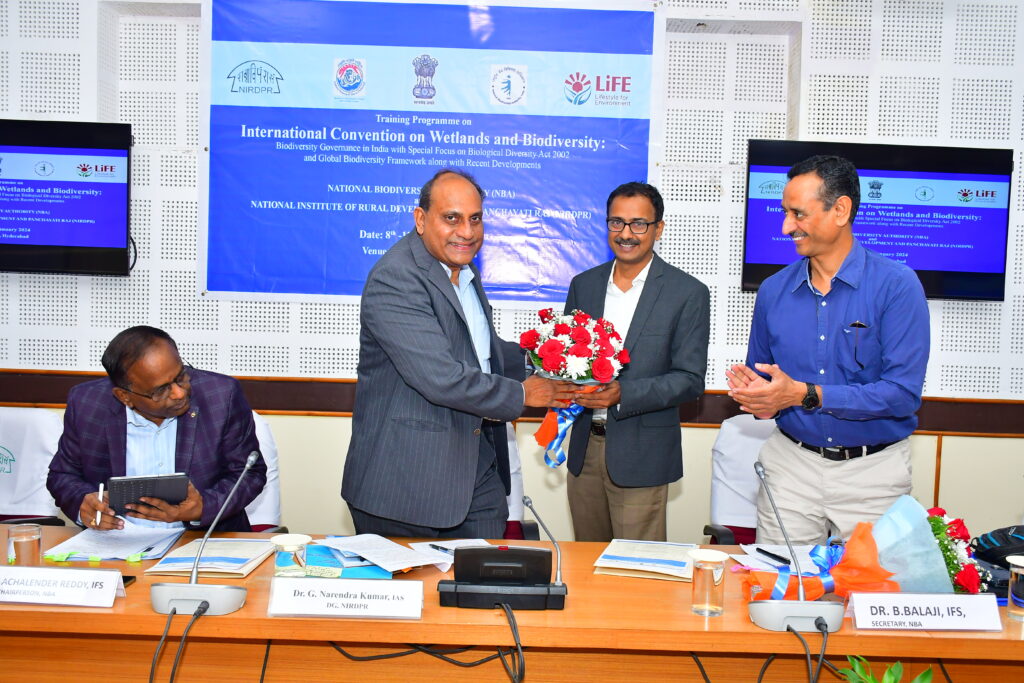
Dr Ravindra S. Gavali delivered the welcome address. In his opening remarks, Dr B Balaji, IFS, Secretary, NBA recalled the long cherished relationship between NBA and NIRDPR in organising various tailor-made training programmes for officers of different capacities. Stressing the relevance of the programme, he said the officers get limited opportunities to update themselves and hence, case studies and field visits are included in the programme. “Wetlands cover around 6 per cent of the Earth’s surface; however, more than 40 per cent of plant and animal species live and breed in it. Such is the importance of wetlands,” he noted.
“In the Convention on Biological Diversity, India is a signatory. We can proudly state that out of 192 signatories, India is a role model for many of the countries. India passed the Biological Diversity Act in 2002, and the access-benefit sharing is the key feature of it, which makes it a tremendous success,” Dr Balaji added.
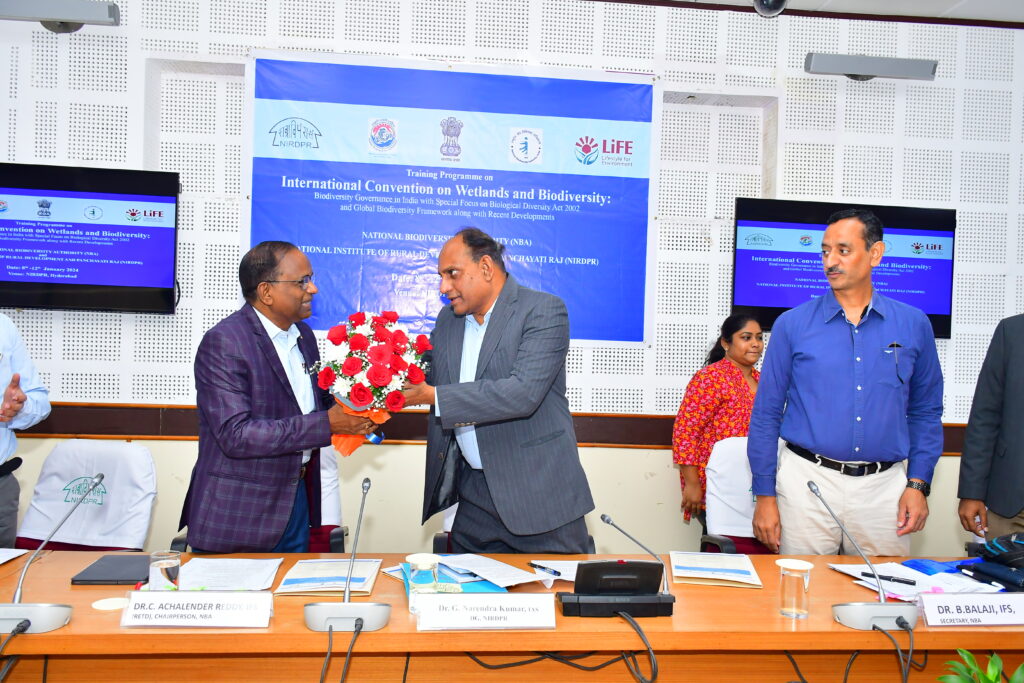
Dr G. Narendra Kumar, IAS, Director General, NIRDPR delivered the inaugural address. Welcoming the dignitaries and participants, he detailed the roles played by NIRDPR as an apex capacity building organisation, a think-tank for the Ministry of Rural Development and a central technical support agency. Further, sharing his experiences as the Managing Director of Cooperative Sugar Mills in Puducherry, he said how he could help farmers tide over the crisis created by red dot disease in high yielding variety of sugarcane, and explained how a success model was devised through crop diversification by mixing indigenous varieties. Further, describing his experience while attending the Chemical Weapon Convention, Narendra Kumar said many products are the results of intensive haggling and negotiations.
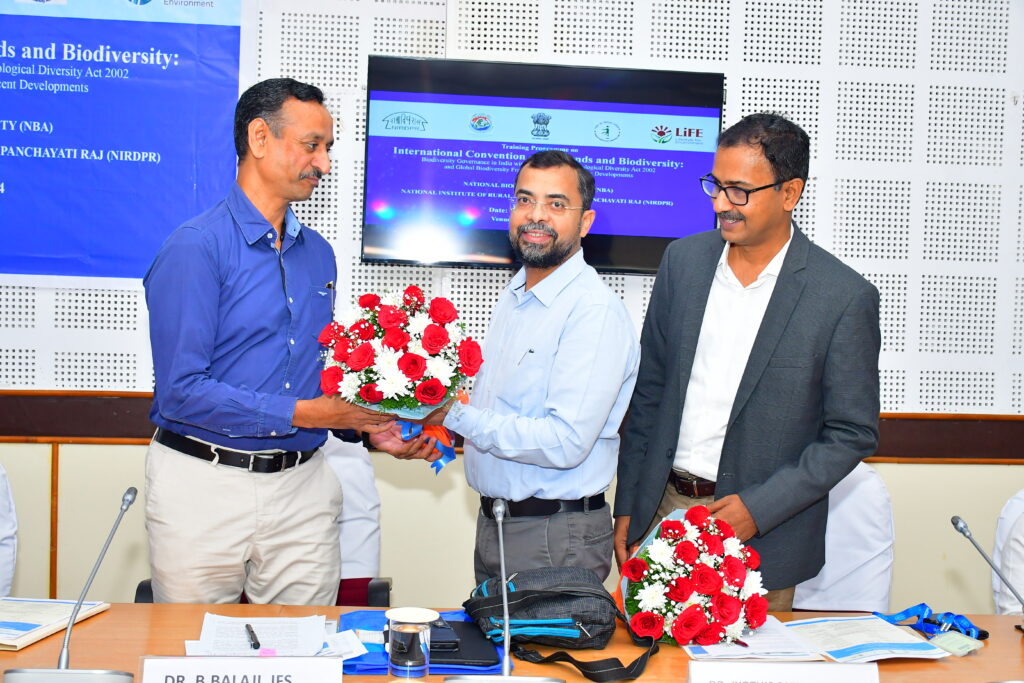
In his special address, Dr C. Achalender Reddy, IFS (Retd.), Chairperson, NBA, shared his experience in various capacities throughout his career. Citing the premature flowering issues faced by Maharashtra bamboo farmers, he detailed the impact of lack of knowledge on the bio-economy. He also briefed about the challenges faced in introducing the concept of ecotourism in Arunachal Pradesh and how it became a success. He added that international conventions play a vital role in bettering the situations by identifying the existing gaps.
Dr Jyothis Sathyapalan, Professor, CNRM, CC&DM and Course Director, proposed a vote of thanks.
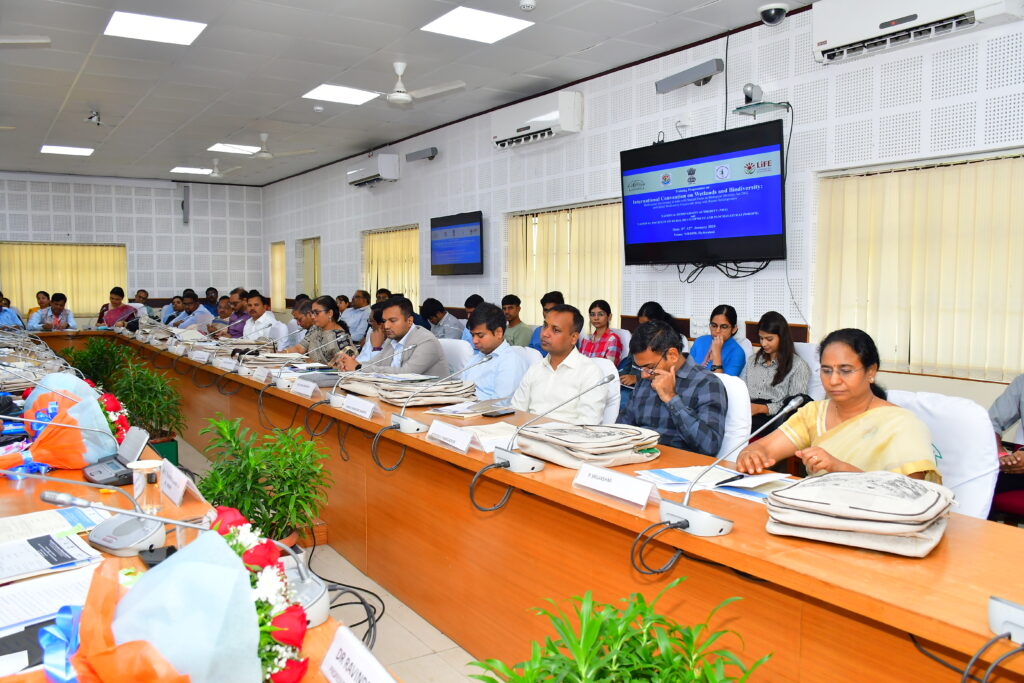
The capacity building on International Convention of Wetlands and Biodiversity was planned to introduce recent changes in the principles and governance tools at the international level to the Indian Forest Service Officers. This programme took a transdisciplinary approach consisting of natural and social scientists from different disciplines and adds value to India’s existing efforts on biodiversity governance promoted by the National Biodiversity Authority. It intended to strengthen state and national ties between researchers and administrators working on managing biodiversity and ecosystem services by creating a well-structured capacity-building community. The programme was designed under the larger perspective laid down in the Kunming Montreal Global Biodiversity Framework by the “Convention on Biological Biodiversity” (CBD), the “Intergovernmental Platform for Biodiversity and Ecosystem Services” (IPBES) and the governance approaches adopted in India’s Biodiversity Act 2002. The programme featured discussions on multilateral environmental agreements/conventions on biodiversity, the Nagoya Protocol, Aichi targets and the Kunming Montreal Global Biodiversity Framework, besides the details of biodiversity action plans at national, state and local levels. The focus was on the governance aspects of biodiversity without compromising the development needs of the people. The training programme was imparted with practical examples from the field and case studies.
CICT, OL Section (CDC) Jointly Organise Training on Google Bard
The Centre for Information Communication & Technology and Official Language Section(CDC) of the National Institute of Rural Development & Communication, Hyderabad organised a training programme on Google Bard,which is a conversational generative artificial intelligence chatbot developed by Google, on 24th January 2024. Besides the staff from Hyderabad, employees of various centres of the Institute, i.e. NERC, Guwahati, Delhi and Bihar centres, attended the programme online.
The programme was organised as per the decision taken in the meeting of the Official Language Implementation Committee held under the chairmanship of Dr G. Narendra Kumar, IAS, Director General, NIRDPR to translate the training materials into various regional languages along with Hindi.
Dr Ravindra S. Gavali, Prof & Head, CNRM, CC&DM, NIRDPR inaugurated the session. Smt. Anita Pandey, Assistant Director, Official Language, NIRDPR explained the present requirement and need for the Google Bard training.
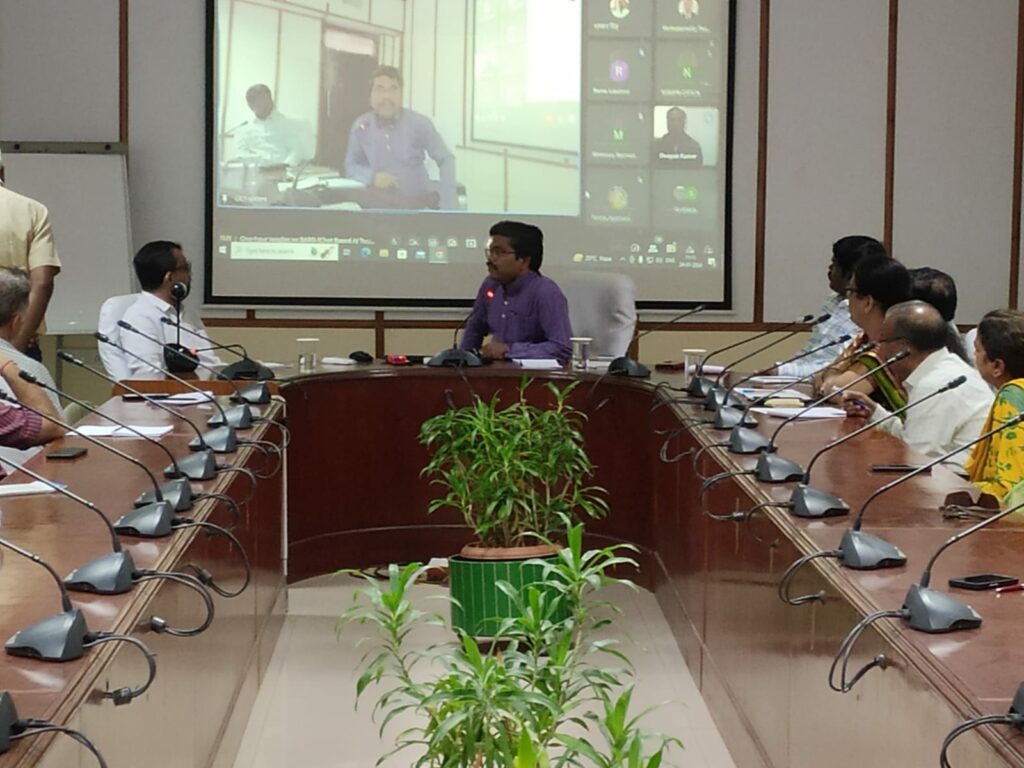
Dr M. V. Ravibabu, Associate Prof. & Head (i/c) CICT gave a presentation on various features in Bard, including translation text and documents into various languages.
Dr M. V. Ravibabu said that Bard is a factual language model from Google AI, trained on a massive dataset of text and code. “It can generate text, translate languages, write different kinds of creative content, and answer your questions in an informative way. As a Google product, we can integrate it with Gmail, Google Drive and YouTube for better output,” he added.
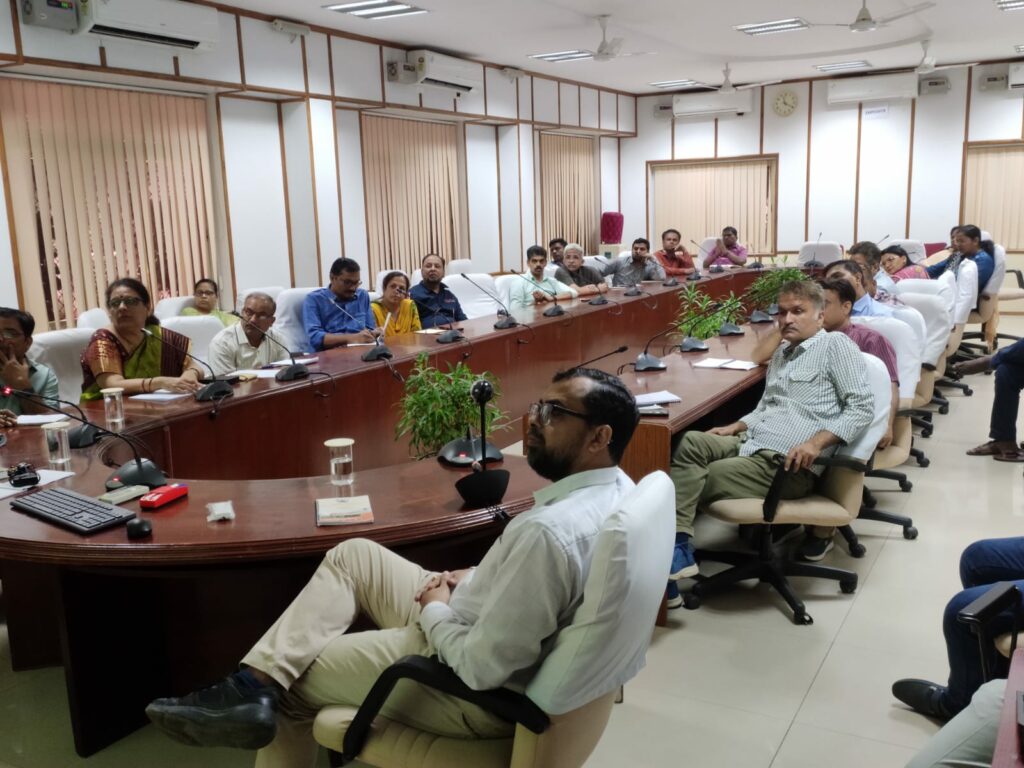
Dr M. V. Ravibabu demonstrated various features of Google Bard and explained how to use it using Google account. He explained that Bard has the capability to move our ideas forward.
“With a little help from Bard, you can brainstorm ideas, develop a plan, or find different ways to get things done, get a quick, easy to understand summary of more complex topics, and create first drafts of outlines, emails, blog posts, poems, etc.
The programme ended with a vote of thanks by Smt. Anita Pandey.
5th Management Development Programme on Rural Development Leadership for BDOs
The Centre for Human Resource Development (CHRD) of National Institute of Rural Development and Panchayati Raj (NIRDPR), Hyderabad conducted a five-day training programme on Management Development Programme on Rural Development Leadership for Block Development Officers (BDOs) on its campus from 18th-22nd December 2023. As many as 26 BDOs from the states of Andhra Pradesh, Bihar, Kerala, Haryana, Meghalaya, Punjab, Rajasthan and Uttar Pradesh attended this programme, which was the fifth in the series. The main objective of this programme was to orient the BDOKs on the concepts of management and rural development relevant to block administration, enable them to learn distinctions of different flagship programmes and its strategies to address the developmental issues, make them recognise their potentials addressing various social sector issues and equip the BDOs on skills to prepare Block Development Vision Plan.
This programme was conducted and coordinated by Dr Lakhan Singh, Assistant Professor, Centre for Human Resource Development of NIRDPR. Before the commencement of the programme, he explained the need, demand and importance of the programme, course design and content and also about the outcome which would enable the BDOs to discharge their duties more effectively when they are back to their positions.
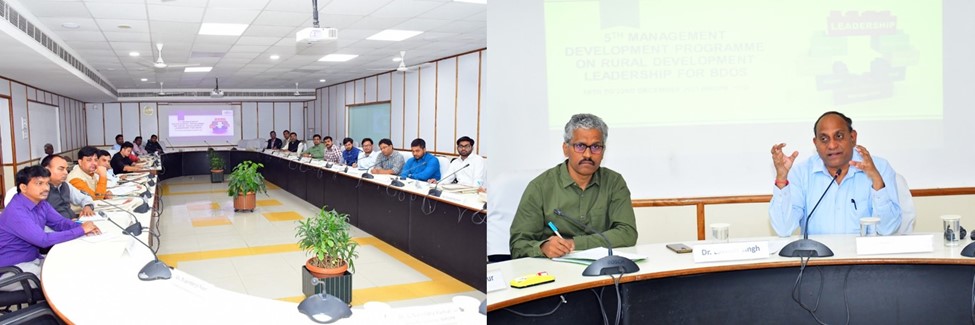
This programme was inaugurated by Dr G. Narendra Kumar, IAS, Director General, NIRDPR. In his inaugural speech, Dr Narendra Kumar emphasised the role and importance of BDOs in the development administration for the effective implementation of the rural development programmes sponsored by both the Centre as well as states. He also highlighted the achievements as well as challenges encountered in the implementation of each of the flagship programmes of the Department of Rural Development and Panchayati Raj, Government of India and possible strategies to overcome these challenges.
Eminent and subject matter specialists delivered the key sessions such as MGMREGS: A Critical Assessment of its performance since inception, Role of SMEs in rural development, Issues of Basic Education in Rural India with special focus on Samagra Shiksha, Improving Quality of Life of Rural Citizens through Aspiration Block Programme – Role of BDOs, Mission Antyodaya: A framework for grassroots planning, Approaches and Strategies towards localization of Sustainable Development Goals, Issues and Challenges in sustaining ODF villages, Issues and Challenges in formulating quality Gram Panchayat Development Plan (GPDP), Understanding Gender Issues for rural development, Transparency and Accountability for Good Governance, Leadership Qualities, Rights based Development and Social Accountability through Social Audit Mechanism, Communication and soft skills including behaviour in Management, Pradhan Mantri Gramin Sadak Yojana: Use of Geo Informatics System, Paradigm shift in rural development, Skilling of rural youth through Deen Dayal Upadhyay Gramin Kaushal Yojana: Role of BDOKs, Scenario of Drinking Water in Rural India, Preparation of Block Development Vision Plan based on ABP goals, etc.
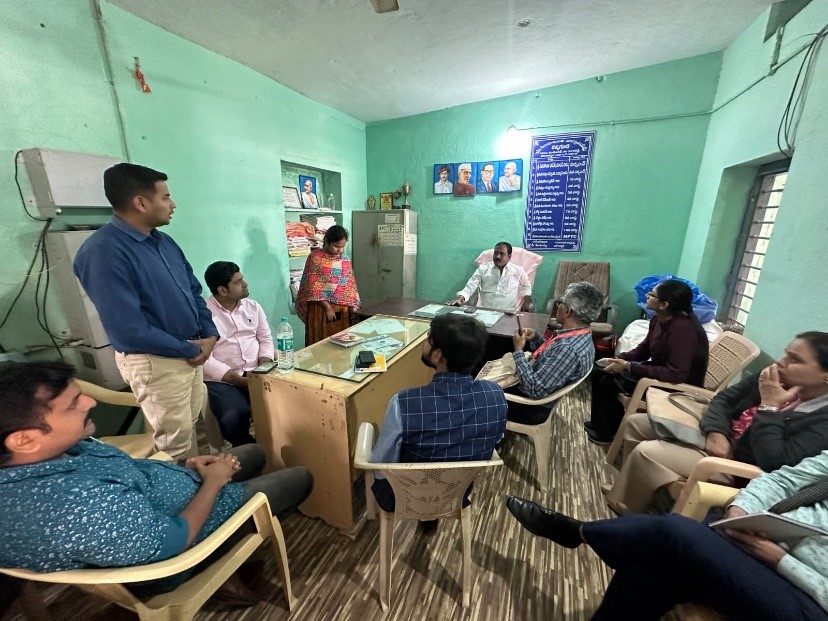
The participants were taken on a field visit to a nearby Model Gram Panchayat where they had the opportunity of witnessing the developmental activities being carried out and interacting with the functionaries of Gram Panchayat. In addition, they also visited Rural Technology Park (RTP) located on the Institute’s campus for a demonstration of appropriate technologies for rural development.
The programme was evaluated on a five-point scale by the BDOs who rated it as excellent. During the valedictory session, the BDOs appreciated the Course Director for designing such a useful programme covering all the necessary topics required for improving the skills and knowledge of the participants. The field visit to a model gram panchayat was more informative where they were briefed about the best practices and success stories.
The participants expressed their utmost satisfaction with the facilities provided to them during their stay at the Institute.
At the valedictory, the participants were felicitated with the Certificates of Participation by the Programme Director.
How SHGs Improved the Economic Condition of Rural Women? A Study in Jorhat District of Assam, India
Dr Shankar Chatterjee
Former Professor & Head, CPME, NIRDPR, Hyderabad
shankarjagu@gmail.com
Prof. Muhammad Yunus of Bangladesh, a renowned economist who was awarded the Nobel Peace Prize in 2006 for the establishment of the Grameen Bank and pioneering the concepts of microcredit and microfinance, is the ‘father of developing Self-help Group (SHG) concept’ of economically backward women of rural areas. In India also, SHGs have been functioning since the Union Government launched the Development of Women and Children in Rural Areas (DWCRA) as a sub-scheme of the Integrated Rural Development Programme (IRDP) in 50 districts in 1982-83. Now Deendayal Antyodaya Yojana-National Rural Livelihoods Mission (DAY-NRLM) is in operation, which is under the Ministry of Rural Development, Government of India.
In December 2023, the author visited Jorhat district of Assam, India to study two SHGs, viz. Rupali SHG at Borphaidya Gohain Gaon and Lakhimui SHG at Holongapar Gohain Gaon. Both these SHGs located at Central Jorhat Block, Central Jorhat Block, Jorhat district were randomly selected to get an idea about the income-generating activities of rural women in the Jorhat district, and the amount of savings by each member in two SHGs, borrowing, and utilizing SHG’s Corpus Fund. The two SHGs were established in two different periods.
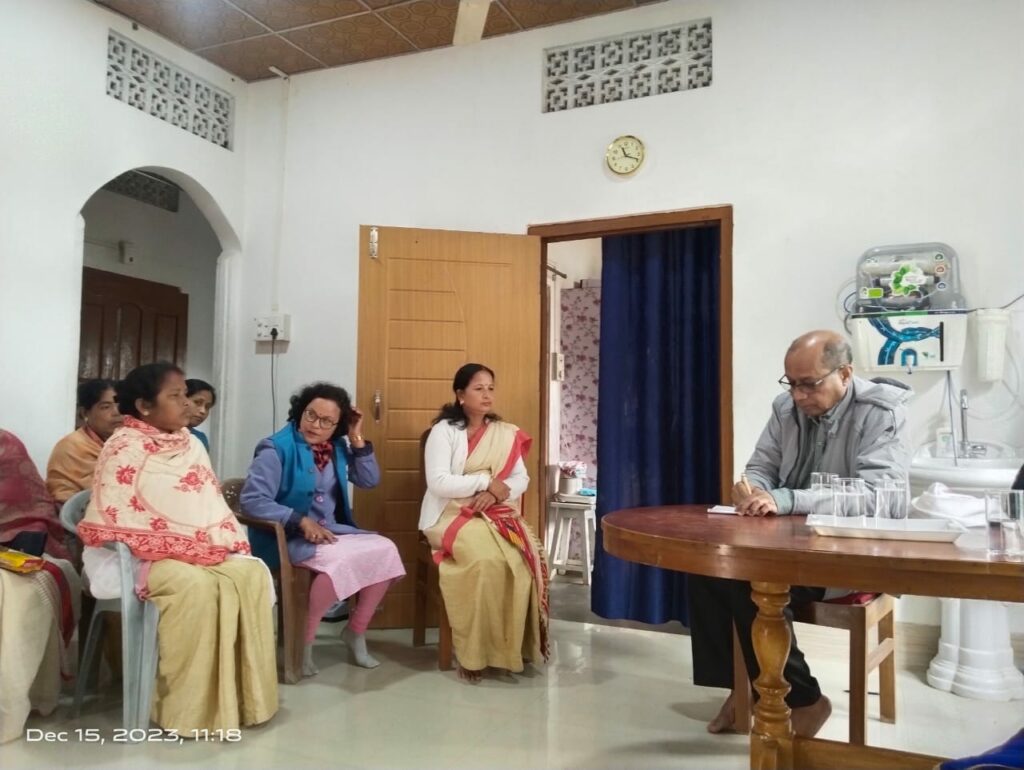
The Rupali SHG was established in 2007 with 12 women from the Other Backward Caste (OBC) community. The Government of Assam supported the SHG through the scheme Vistarita Kanaklata Mahila Sabalikaran Yojana (VKMSY). All 12 women members were present, and it was observed that their economic condition greatly improved after forming the SHG.All members have attended school with a minimum educational qualification of eighth standard and a maximum of 10th Pass. The initial savings per member per month of Rs. 20, was later enhanced to Rs. 100 per month per member. All the members own agricultural land, and based on land holdings, they can be termed marginal farmers.
The SHG was provided with a Revolving Fund of Rs. 15,000 (one-time grant) and Rs. 50,000 as a Vistarita Karnataka Mahila Sabalikaran (VKMS) Scheme (Grant). In addition, the SHG was provided with bank loans from time to time – initially, a bank loan of Rs. 50,000, then Rs. 1 lakh, and lastly Rs. 5 lakh (August 2022 repayment of which was going on when the study was conducted). The author interviewed randomly four women members, namely Ms Raju Dowrah (40 years, ninth pass), Ms Dipali Borghain (45 years, 10th pass), Ms Rinjumoni Dowrah (31 Years, ninth pass) and Ms Nikhamoni Borgohain (28 years, 11th pass). It was observed that all of them borrowed several times from the Corpus Fund of the SHG and spent for assets generation, such as purchasing cows, goats and poutry birds, agricultural development, etc. As reported, the minimum income was Rs. 20,000 per month, and the maximum was Rs. 40,000. During interaction, Ms Nikhamoni Borgohain said that within two years of marriage, her husband left her with a son and got married again. The SHG members greatly supported her and at present, she is self-dependent as her only son, 11 years old, attends school. She stays at her mother’s house and owns one-acre agricultural land.
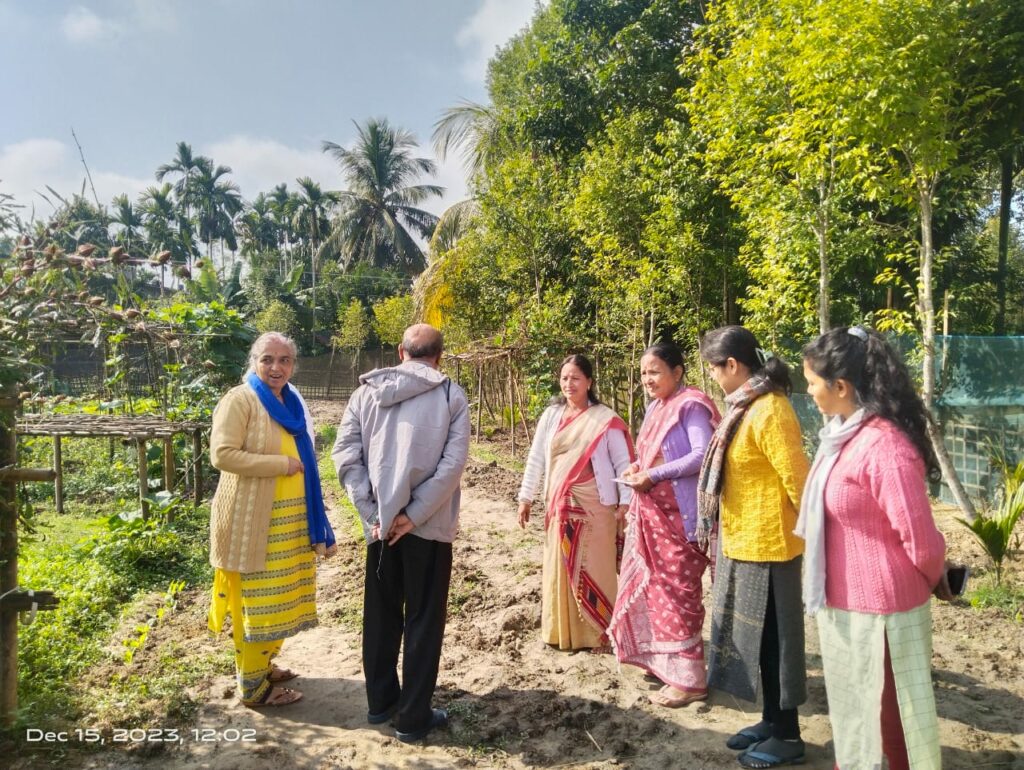
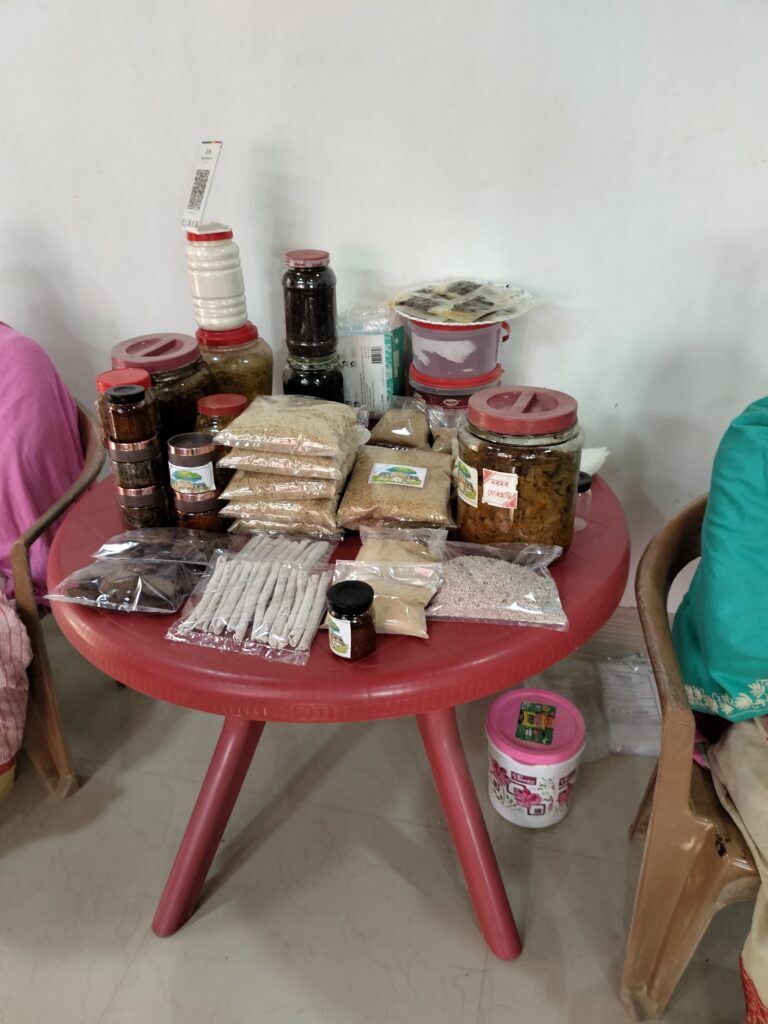
Lakhimi SHG of Holongapar Gohain Gaon village was established in 2018 by 10 women members belonging to the Other Backward Caste (OBC) and all the members were literate – middle school to 12th pass and had agricultural land between one acre and three acres. All members borrowed on numerous occasions from the Corpus Fund of the SHG. The savings of each member was Rs. 100 per month, which continues till the day of study. As an SHG, they received Rs. 25,000 as a Revolving Fund (RF) and Rs. 50,000 as a one-time grant from the Government of Assam under the Vistarita Kanaklata Mahila Sabalikaran Yojana (VKMSY). From time to time, the SHG secured bank loans – Rs 1 lakh in 2019, Rs. 2 lakh in 2021, and finally, Rs. 3 lakh in December 2022 (the repayment was going on during the study). Altogether five members of the SHG were contacted to get an idea about their activities and found that they bowered several times from the Corpus Fund of the SHG.
The author randomly interviewed four female members – Ms. Minima Baruah Borpatra (48 years 12th pass), Ms. Rinumoni Borah ( 40 years 10th pass), Ms. Minu Borpatra (40 years, 10th pass), and Ms. Dipti Barman (40 years,10th Pass) – to get an in-depth idea about utilising loans. All spent the loan to purchase cows, goats, and poultry birds, agricultural development, etc., in addition to the welfare of the family members. It is noteworthy to mention that duck eggs and meat are popular in that region of Assam. The author, during the study on SHGs across India and abroad, has observed that the rural women felt empowered after forming SHGs as their economic condition improved through income-generating activities. The same is the case in Jorhat district. Hence, it is suggested that the Government of Assam should give more importance to forming SHG among rural women. The launching of Vistarita Kanaklata Mahila Sabalikaran Yojana (VKMSY) by the Government of Assam to support SHG is a praiseworthy step in this direction.
International Training Programme for Elected Representatives of the Republic of Maldives
The Centre for Panchayati Raj, Decentralised Planning and Social Service Delivery, NIRDPR organised an international training programme on Leadership Development for Elected Representatives of Island Councils of the Republic of Maldives from 17th January -01st February 2024 on its Hyderabad campus. The participants of the capacity building and training programme represented a diverse array of stakeholders from the Maldives, comprising Presidents, Vice Presidents, and Council Members hailing from the atolls of Shaviyani, Noonu, Raa, and Lhaviyani. A total of 29 participants (13 women & 16 men) from various Island councils of Male –Council Presidents, Council Vice Presidents, Council Members, hailing from the atolls of Shaviyani, Noonu, Raa, and Lhaviyani, Local Government Authority Officials from the Republic of Maldives, Ministry of external Affairs, Male attended the training programme.
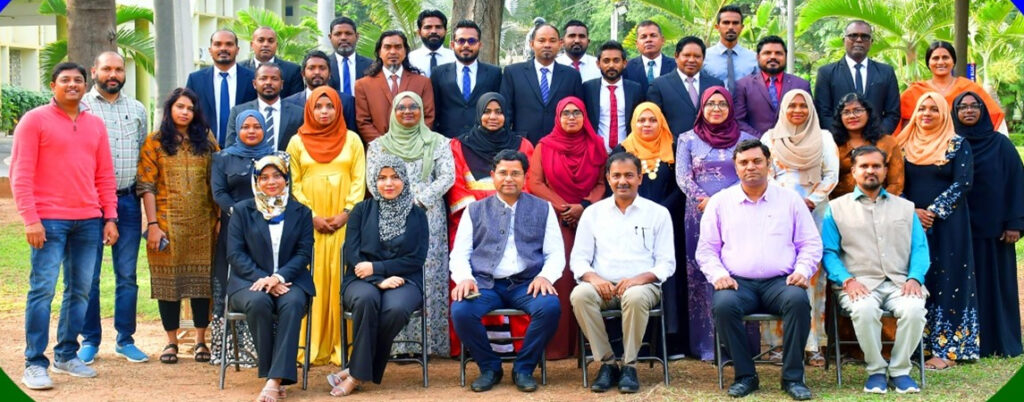
After the self-introductory session, the inaugural address was delivered by Dr Anjan Kumar Bhanja, Course Director & Associate Professor & Head, CPRDP&SSD, NIRDPR. Extending a warm welcome to the officers, he shared his views on the 2-week programme structure and gave a brief overview of how NIRDPR has been working to reduce poverty through several government schemes. Through a blend of theoretical frameworks, practical training modules, and knowledge-sharing sessions, the programme endeavoured to equip participants with the requisite skills, knowledge, and tools to navigate the complexities of local governance, foster community engagement, enhance service delivery mechanisms, and chart a course towards inclusive and sustainable development.
The keynote address delivered by Dr. Jyothis Sathyapalan, Professor & Head, CPGS&DE, NIRDPR gave brief insights on fisheries and climate change which plays a major role in the context of Maldives.
The session began with a vibrant meet and greet, followed by an address from the Chief Executive Officer of Local Government Authority, her Excellency Dr. Mariyam Zulfa providing participants with the opportunity to connect with one another and establish networks within the diverse cohort. Amidst an atmosphere of camaraderie and anticipation, participants exchanged introductions, fostering a sense of community and collaboration from the outset.
This training programme covered various aspects related to the theme, viz. (i) Expansion of the vision of the representatives of Island Councils about the roles that they can play more significantly in developing the status of people in the councils, (ii) Promoting Leadership among members of councils, (iii) Exposure to a start-up in Hyderabad, viz. a T-Hub, (iv) Need for Localisation of Sustainable Development Goals and scope for attainment of the SDGs through Local Councils and Island Councils with special reference to the good practices in India, (v) Scope of improving the status of service delivery, redressal of public grievances, Social Protection and social cohesion in favor of Island councils of Maldives, (vi) Scope for political, economic empowerment with reference to a few good practices, (vii) Community-led score card, (viii) Visit to a Udunulapadu gram panchayat and Bethemcherla Mandal Panchayat, SHGs, SHG federations in Kurnool District to experience the political and economic empowerment, (ix) Visit to The Mahila Mart at Bethemcherla, (x) Best practices in solid waste management in India, (xi) Rural Entrepreneurship in the context of economic development in Maldives, (xii) Healthy group dynamics with focus on leadership, participation, communication, facilitation, decision-making, conflict resolution, stages of group development and significant effects of able leadership-in the functioning of Island Councils, (xiii) Scope for emulating innovative and appropriate rural technology in Maldives based on a few good practices including the RTP (Rural Technology Park), (xiv) Scope for improvement in fisheries sector in Maldives based on the good practices in India, (xv) Visit to Indian National Centre for Ocean Information Sciences (INCOIS), (xvi) Visit to Integrated Farming at PJTSAU, and (xvii) Visit to Geological Survey of India.
CPRDP & SSD and NIRDPR’s in-house faculty members and select guest faculty as subject matter specialists cum practitioners with rich experience and expertise in the areas of – Rural Development (RD), Self-Help Groups (SHGs), Livelihood Promotion, Panchayati Raj, NRLM, Rural Entrepreneurship, Wind and Solar Technology etc., have participated in the programme and contributed to the success of the programme.
A range of training methodologies were used during the training programme, duly keeping in view its broad and specific objectives, duration and expectations of the participants. It included lectures and interactive sessions with the help of PPTs, video clips, short films and discussions, recap sessions by the participants before the commencement of regular sessions every day, field visits to RTP, Gram Panchayat, SHGs, Udumulapadu Village, Dhone (Mandal), Nandyal (Dist), Mandal Panchayat, Bethemcherla, Nandyal (Dist), and Exposure Visit to T-Hub, GSI, PJTSAU, NFDB, and INCOIS.
To impart practical knowledge and reinforce the learning made in the classroom, field visits were organised to the following places.
Rural Technology Park (RTP): Dr C. Kathiresan, Associate Prof. & Head, CIAT, NIRDPR & Mr. Mohd. Khan, Senior Consultant, CIAT, NIRDPR, with the help of PPTs, video clips, and unit visits, explained the activities of RTP emphasising the importance of frugal innovations in the rural economy. The participants wer introduced to a variety of models of rural technologies showcased in respect of rural housing, renewable energy and natural resource management and skill development & promotion of entrepreneurship, and they appreciated RTP’s guiding principles which included use of local resources, cost-effectiveness, eco-friendly and blending tradition with modern technologies.
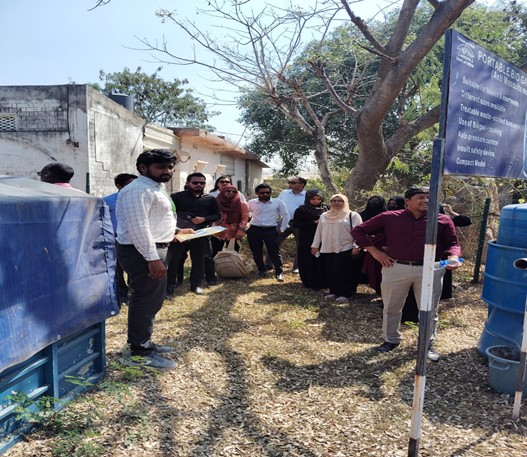
Udumulapadu Gram Panchayat: The GP is located in Dhone mandal of Nandyal district. This Panchayat comprises 10 wards and 450 households with a total population of 2241. The visitors’ interactions focussed on understanding the different activities done under the GP with respect to sanitation, health and nutrition, vaccination, education to children, and employment provided under different schemes of the Central and state governments. They were also excited to know about the convergence of various line departments under one roof, where any grievance would be solved within 15 days.
Bethemcherla Mandal Panchayat: It is located in Bethemcherla mandal of Nandyal district. The participants interacted with all the officials of the line departments presented in the Mandal office and were asked to explain the various activities undertaken by the Mandal, how the support is provided to the gram panchayats when they are in need, deliverables given to the people of the gram panchayat, the mechanism rendered support various departments like sanitation, irrigation, health, water management, solid & liquid waste management, education, emergencies, etc. The visitors were given an overview of the Mandal activities before their visit to the Mandal panchayat activities sites for better understanding. The authorities shared some success stories to explain as to how women are being assisted by forming SHGs to get gainfully employed to support their families, and improve their social status and livelihood in the process. Later, they visited Mahila Mart at Bethemcherla run by SHG women.
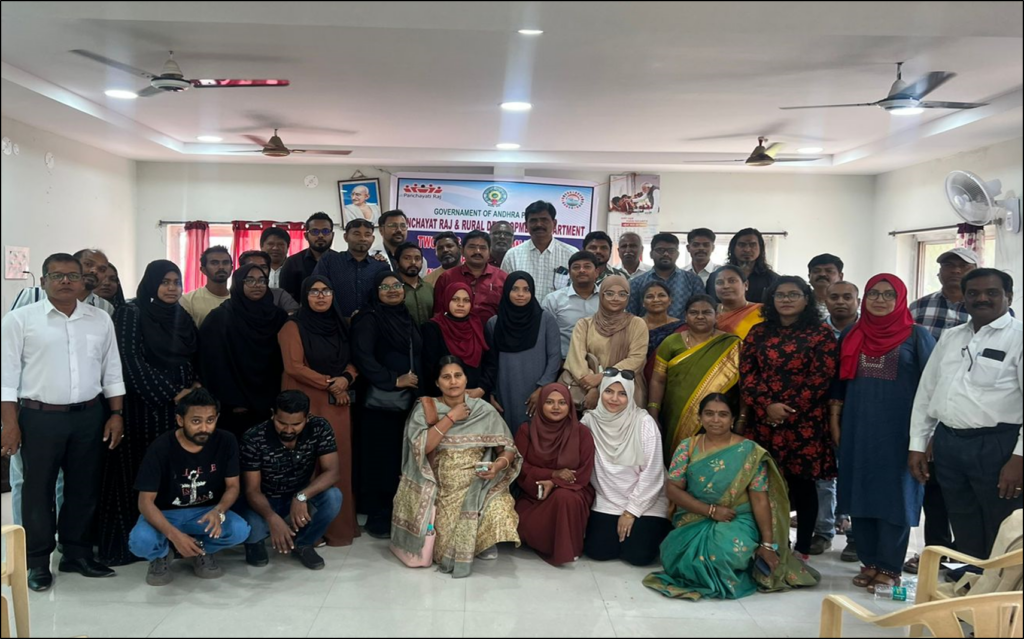
The participants were cooperative and punctual in attending the training sessions. The programme was a success, as per the feedback received. All the participants felt that the programme was organised in a systematic manner. Further, they felt that the serene training ambience, clean and hygienic surroundings and the infrastructure facilities (classrooms, guest rooms, food, hospitality and others), led to the success of the training programme.
UBA Cell, NIRDPR Conducts Mission LiFE Programme at SNVPMV, Hyderabad
Under the aegis of Unnat Bharat Abhiyaan, the UBA cell of NIRDPR conducted a Mission LiFE program at Sarojini Naidu Vanita Pharmacy Maha Vidyalaya (affiliated to Osmania University), Hyderabad on 20th January 2024.
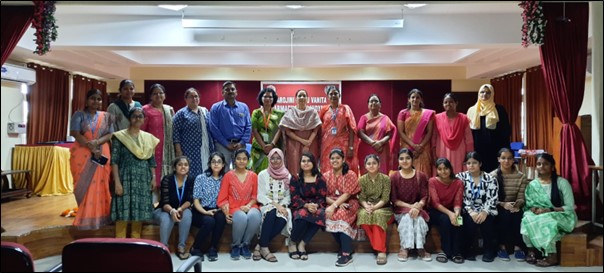
Dr. R. Ramesh, Associate Professor & Head, Centre for Rural Infrastructure delivered a talk on ‘Avoiding Plastics: What you and I can do about it’ along with an orientation on the UBA programme. The orientation talk was well-received by both the faculty members and students of the college who were quite enthusiastic and have already planned a roadmap of development in a nearby rural area. Further, Dr Sonal Mobar Roy, Assistant Professor, Centre for Wage Employment and Livelihoods delivered a talk on ‘Adaptation of Sustainable Food Systems’ under the theme of Adopting Healthy Lifestyles in Mission LiFE. Both the lectures were interactive in nature and a short video was also showcased.
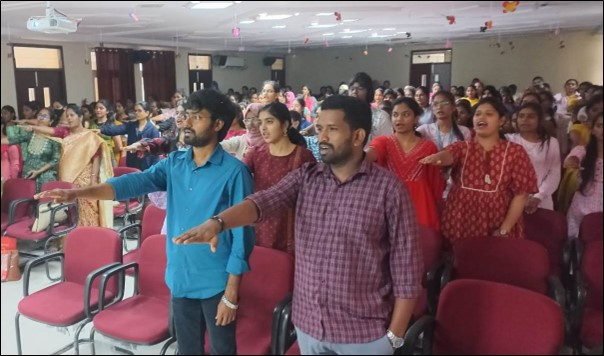
Mission LiFE pledge was administered to one and all present in the auditorium. The Mission LiFE aims to create awareness about the importance of conservation, moderation, and sustainable practices. It aims to mobilise a large number of people to actively take part in the campaign. The program was attended by 167 students along with faculty members of the college.
Aspiring to Make a Poverty-Free Panchayat: The Story of Jharnipali Gram Panchayat in Odisha
Mr Yaspalsingh Yadav
Young Fellow, NIRDPR
Introduction
Recently, there has been a rise in gender discourse in terms of gender-led development, women empowerment, and their enhanced participation in all walks of life, especially in local institutions such as Gram Panchayats. Women’s participation in the labour market and entrepreneurship is improving, albeit very slowly. They still face various types of discrimination, and more so in rural areas.
Women in India display the courage and capability to do multiple works. But at the same time, they face several challenges, such as gender discrimination, gender gap, glass ceiling, gender roles, etc., to achieve their goals. With limited opportunities and the patriarchal mindset prevailing in society, women face a lot of obstacles. When a woman is a single mother and the whole household is reliant on her, the challenge doubles up, and the dearth of economic opportunities with the added responsibility of nurturing a daughter/son by providing them quality education and food, and giving them an identity in society becomes a daunting task for her.
NIRDPR started an ambitious project in 2021 for creating model GP clusters in select Panchayats across the country. Jharnipali in Agalpur Block of Balangir district of Odisha (LGD code 115767) is one of the clusters where the project is being implemented to prepare good quality GPDP and capacitate PR functionaries to perform their duties and responsibilities and strengthen the gram panchayat to achieve holistic and sustainable development.
A gram panchayat has all the responsibilities to implement various governmental schemes. But Jharnipali gram panchayat has moved a step ahead towards showcasing itself as a strong self-government institution. During the COVID-19 outbreak, the gram panchayat took many steps to manage the situation. In addition, it continuously works towards the eradication of malnutrition and undertakes several measures to make the village self-sufficient and poverty-free.
Role of the Gram Panchayat
The gram panchayats, with limited funds available apart from grants made from the Central Finance Commission and State Finance Commission, have their own source of revenue. But despite having a low own source of revenue generation, Jharnipali tried to resolve many important issues out of OSR. The gram panchayat prepares Gram Panchayat Development Plans (GPDP) every year to ensure its developmental needs and aspirations, and to solve the issues which the first tier of local self-government are facing.
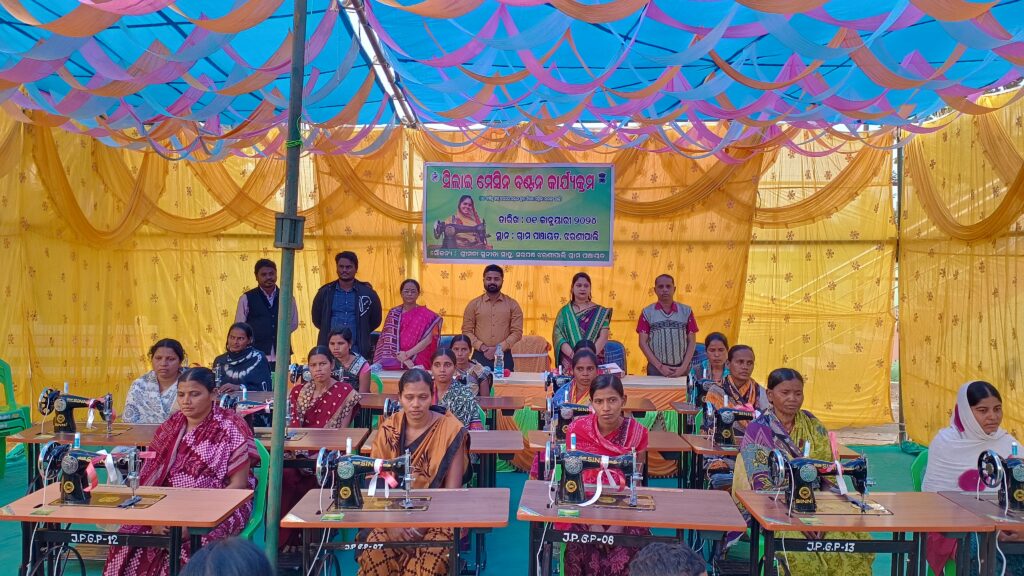
Efforts of Gram Panchayat to Generate Livelihood
Under the leadership of woman Sarpanch Smt Sunita Sahu, Jharnipali has been undertaking several steps to address various social and economic issues. She realised that empowering women acts as an indispensable tool to make a developed society, which ultimately leads to a poverty-free society and the accomplishment of localisation of SDGs. It is trying to set an example of a model gram panchayat by focusing on women empowerment. Recently, the gram panchayat garnered attraction when it tried to mitigate poverty in a unique manner. The gram panchayat discussed the poverty-free and enhanced livelihood village with its Standing Committee members. The committee decided to provide income-generating opportunities to the most helpless and burdened women of the panchayat in the year 2024. Hence, it was decided to provide sewing machines to widowed women who have children aged less than 20 years. This has been decided thoughtfully to make them self-employed, thereby helping them to meet their children’s financial and educational needs. To identify the beneficiaries, a survey was conducted, and 15 widows were selected who met the criteria set by the gram panchayat. The panchayat further distributed the sewing machines to the selected beneficiaries besides arranging the much-needed training twice a month to help them take it as an income-generating activity. The District Collector appreciated this effort and urged nearby panchayats to replicate similar initiatives.
However, to make such an initiative a success, it is important to help them connect with the market. The gram panchayat is looking forward to tying up with some local players in this sector to give them a boost. These women should also be exposed to higher-order skills and training. These beneficiaries need to be connected with other schemes and programmes of the central and state governments. For instance, under NRLM-DDUGKY, these women may be provided with skilling as well as other support, if any. They may also be linked to RSETIs on training programmes relating to the operation of industrial sewing machine and tailoring. Through proper education and skill development, such single mother-headed households can be empowered socially and economically.
What They Said
Women empowerment is key to the success of the panchayat and Jharnipali is looking forward with new energy to make them self-sufficient which will help them to meet familial needs such as education and health. I request other stakeholders in rural development to come forward and make Jharnipali gram panchayat a model to emulate.
Smt. Sunita Sahu, Sarpanch, Jharnipali gram panchayat
A good start to the new year and a lot of appreciation to the Sarpanch of Jharnipali for taking such innovative steps which will result in the economic independence of the beneficiaries.
Shri Kuldeep Mohanty, BDO
I thank the Sarpanch for taking such an innovative step which is going to make women more economically viable.
A Beneficiary
The Gram panchayat has taken many steps towards women’s development. After getting the free sewing machine from Gram Panchayat, I feel the satisfaction of contributing to the family and catering to their needs. I thank the Sarpanch for providing this.
A Beneficiary
The Gram Panchayat has given us sewing machine. After learning to sew properly, I will be able to meet the needs of my children and support them.
A Beneficiary
(The author extends sincere thanks to Dr Anjan Kumar Bhanja Associate Professor and Head, CPRDP&SSD, NIRDPR and Shri Dilip Kumar Pal, Project Team Leader for their continuous guidance and support. The author also thanks Dr Partha Pratim Sahu, Associate Professor and Head, CGG&PA, NIRDPR for the initial discussion and suggestions on an earlier draft of this note.)
Hindi Workshop on Unicode Organised at NIRDPR
As per the annual programme of the Department of Official Language, Ministry of Home Affairs, New Delhi and with the approval of the competent authority, a Hindi workshop on Unicode Software was organised for the Group ‘B’ and ‘C’ employees of the National Institute of Rural Development and Panchayati Raj, Hyderabad, on 31st January 2024.
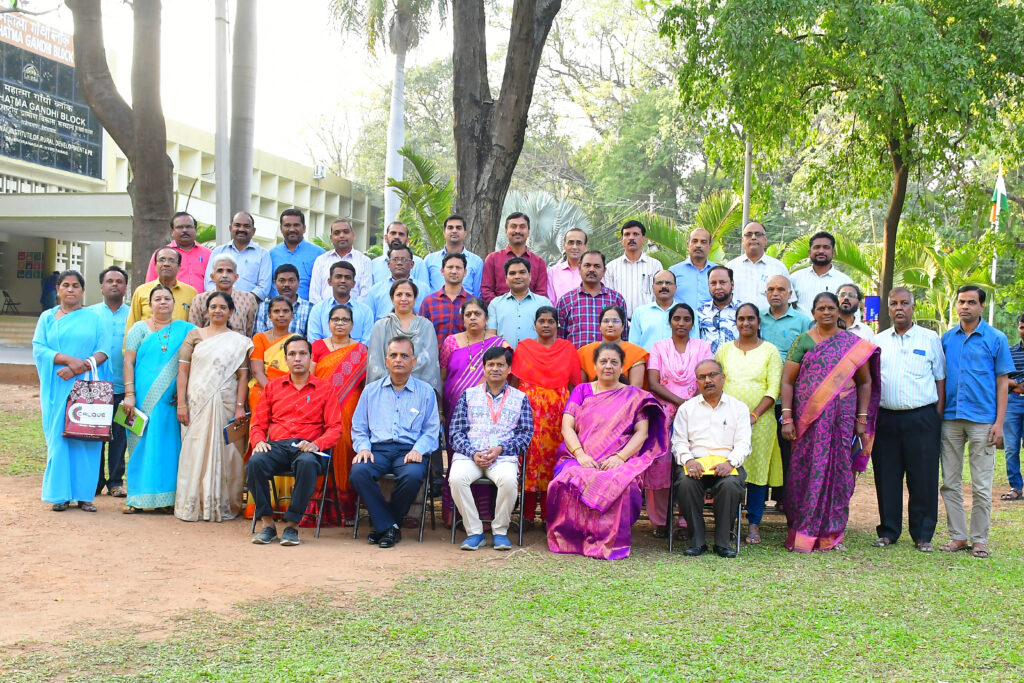
Dr P.K. Ghosh, Assistant Registrar (Estt.), NIRDPR Guest Speaker Shri Jaishankar Prasad Tiwari, Assistant Director (Retd.), Hindi Teaching Scheme, Secunderabad and Mrs. Anita Pandey, Assistant Director (Official Language), NIRDPR were present.
Dr P.K. Ghosh, AR(E) who was present as the chairman, recalled his experience related to learning Hindi language and the status of Hindi work in the Institute. He also highlighted the progress of the implementation of official language in the Institute.
Mrs. Anita Pandey, Assistant Director (Official Language) presented the outline of the Hindi workshop on Unicode and highlighted its importance.
Guest Speaker Mr Jaishankar Prasad Tiwari delivered a lecture to the officers/employees about letter writing, and translation through speaker on Google Translation and Google Docs.
Further, Mr M. Sundara Chinna, Data Processing Assistant of the Institute, made a presentation on Google Bard, a translation platform (bardgoogle.com).
Shri E. Ramesh, Senior Hindi Translator, compered the workshop and proposed a vote of thanks.
Nearly 40 employees of the Institute attended the workshop. The employees of the Official Language Section coordinated the workshop.
NIRDPR Official Attends Regional Official Language Conference
With reference to the letter received from the Deputy Director (Implementation) and Centre In-charge of the Regional Implementation Office, Bengaluru, Mrs. Anita Pandey, Assistant Director (Official Language), NIRDPR participated in the Regional Official Language Conference for South and South-West Regions and Award Distribution Ceremony organised by the Department of Official Language, New Delhi, Ministry of Home Affairs, in Bengaluru, on 19th January 2024.
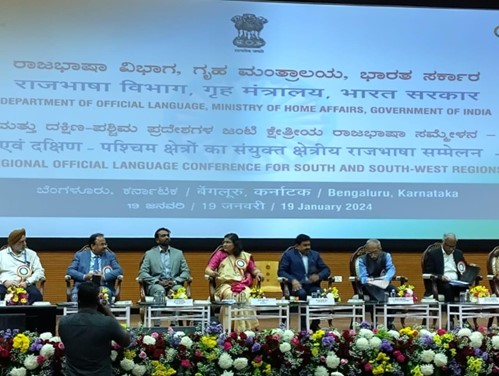
Shri Ajay Kumar Mishra, Hon’ble Minister of State for Home, Government of India, was the Chief Guest of the event. Mrs. Anshuli Arya, Secretary, Department of Official Language, Mrs. Meenakshi Jolly, Joint Secretary, Department of Official Language, Commodore A. Madhavarao, Managing Director of BDL (Retd.) and other distinguished officers were present.
Addressing the gathering, Shri Ajay Kumar Mishra, Hon’ble Minister of State for Home explained the work done by the government to increase the use of official language Hindi in every field. “Hindi is easily understood and spoken by the common people. The Department of Official Language, Ministry of Home Affairs has done the work of connecting the central offices of the cities through the Town Official Language Implementation Committees (TOLIC). The Department of Official Language, Ministry of Home Affairs, works for the promotion of the official language under the supervision of the Parliamentary Official Language Committee,” he said and appreciated the work of the Department of Official Language.
Mrs. Anshuli Arya, Secretary, Department of Official Language, welcomed the guests of the programme and gave detailed information about the promotion of Hindi in South India. She praised the better performance of Hindi in the southern and southwestern states and the work of the Town Official Language Implementation Committee (TOLIC). The guests present on the stage also expressed their views. After the vote of thanks by Mrs. Meenakshi Jolly, Joint Secretary, Department of Official Language the programme ended with the national anthem.
Training Programme on Development of Managerial Skills for Fishery Officers from Odisha
The Centre for Natural Resource Management, Climate Change and Disaster Mitigation, NIRDPR organised a four-day training programme on ‘Development of Managerial Skill, Leadership Development, Extension and Accounting for the Fishery Officers, Govt. of Odisha’ from 19th to 22nd December 2023. A total of 19 officers from the Fishery Department, Odisha State attended the training programme.
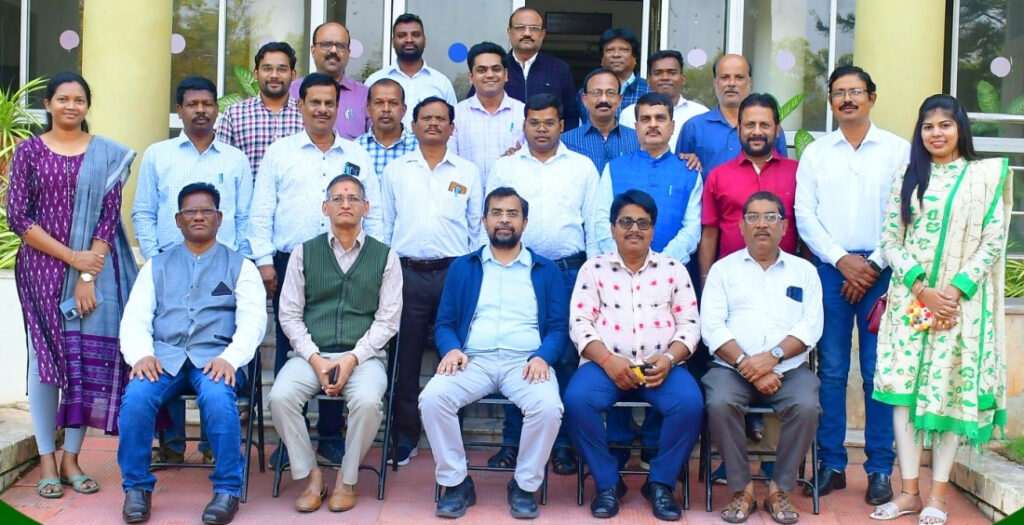
The key objectives of the programme were to enhance managerial skills, improve their extension techniques and strengthen their accounting and financial management skills.
The inaugural session of the training programme commenced with a warm welcome from the course team. Dr. Ravindra S. Gavali, Professor and Head of CNRM, CC&DM, delivered the inaugural address, highlighting the vital significance of sustainable fisheries management.
In the first technical session, Dr V. G. Nitya, Assistant Professor, CAS, NIRDPR, delivered an insightful session shedding light on the pivotal role of Farmer Producer Organizations (FPOs) within the Fisheries sector. Focusing on the conceptual understanding of FPOs, her lecture highlighted their significance in fostering collective action, resource mobilization, and enhancing market access.

Dr. V. K. Reddy’s lecture in the second session on Principles and Practices of Teamwork was enriched with insightful group exercises. These exercises were thoughtfully integrated to illustrate and reinforce the key concepts discussed. Participants actively engaged in collaborative activities that emphasised teamwork, communication, and problem-solving skills.
In the next session, Dr. P.P. Sahu, Associate Professor, NIRDPR, delivered a compelling discourse on promoting entrepreneurship in the fishery sector. His insightful session highlighted key strategies and opportunities for fostering entrepreneurial activities within the industry. Dr Sahu emphasised innovative approaches, market insights, and potential challenges, offering a comprehensive roadmap for aspiring entrepreneurs.
The second day started with a session by Mrs Nagalaxmi, Senior Accountant, NIRDPR, on fundamental concepts of financial accounting, focusing on profit and loss accounts, balance sheets, fund flow, and cash flow statements. Further, Dr. Swarnalatha Jagarlapudi, a distinguished professor at ASCI, conducted an engaging session on managing workplace stress. Integrating participant involvement, she orchestrated survey exercises, encouraging active engagement to gauge stress factors. Dr. Swarnalatha also facilitated cross-lecture interactions, fostering a dynamic learning environment.
In the final session of the day, Dr. A. K. Saxena delivered a lecture on leadership and motivational skills. He employed innovative learning methods, incorporating fun and fact-based exercises that captivated participants. Through interactive sessions, attendees were immersed in practical scenarios, fostering skill development and deeper comprehension. Dr. Saxena adeptly combined theory with engaging exercises, encouraging active participation and enabling attendees to grasp leadership principles effectively.
On the third day, Dr Subrat Kumar Mishra, Deputy Director at SIRDPR, Odisha, conducted an enlightening session on the convergence of rural development programmes with the Pradhan Mantri Matsya Sampada Yojana (PMMSY). His presentation highlighted the seamless integration of PMMSY with existing rural development initiatives. Dr. Mishra adeptly illustrated how this convergence enhances the effectiveness of rural programs, fostering holistic growth and sustainable development in the fisheries sector.
This was followed by a lecture delivered by Dr Ganesh Kumar, Principal Scientist, NAARM, Hyderabad, on farmer and market linkage within the fishery sector. Highlighting the crucial nexus between farmers and markets, and elucidating strategies to strengthen this connection, Dr Ganesh detailed innovative approaches and market-oriented techniques, empowering participants with knowledge on efficient market access and fostering a symbiotic relationship between fishery farmers and markets for enhanced profitability and sustainability.
The institutional visit to INCOIS, Hyderabad, proved to be an enriching experience for participants. They were afforded a unique opportunity to witness the functioning of the Tsunami Early Warning System, gaining valuable insights into its operations.
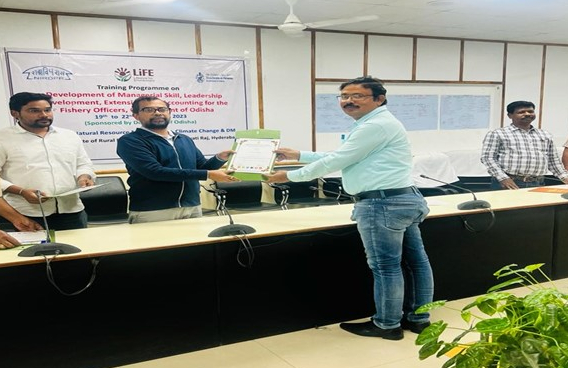
In the final session of the programme, Professor Ravindra S. Gavali, Head of the School of Sustainable Development, NIRDPR, delivered a lecture on climate change adaptation within the fishery sector. His session focused on innovative strategies to mitigate the impact of climate change on fisheries. Professor Gavali actively engaged participants by conducting a survey, soliciting their insights on adapting to climate change in the fishery sector.
During the valedictory session, Professor Ravindra S. Gavali commended participants for their dedication. Certificates were distributed to acknowledge their successful completion of the training program. A post-training assessment was also conducted through a comprehensive test, gauging participants’ grasp of the covered materials. Additionally, Professor Gavali took feedback, ensuring a holistic understanding of participants’ experiences and insights. This comprehensive approach ensured not only recognition but also assessment and feedback for continuous improvement in future programmes.
NIRDPR Observes Mahaparinirvan Diwas
The National Institute of Rural Development and Panchayati Raj, Hyderabad observed Mahaparinirvan Diwas on 6th December 2023 in memory of Dr B.R. Ambedkar.
Dr G. Narendra Kumar, IAS, Director General, NIRDPR, followed by Administrative & Accounts officers, faculty members and staff offered floral tributes to the bust of Dr B.R. Ambedkar at the Dr B.R. Ambedkar Block on the Institute premises.

Addressing the gathering, Dr G. Narendra Kumar said the occasion gives us an opportunity to take a closer look at the life of Dr B.R. Ambedkar and the lessons we learnt from it.
He further urged everyone to read ‘The Journey of Baba Saheb Ambedkar – Life, History & Works’ brought out by the Press Information Bureau to learn more about his life and the struggles he confronted. The DG also briefly touched upon the childhood of Dr B. R. Ambedkar and the struggles he faced to reach greater heights despite losing his parents at a very young age.
“Dr B. R. Ambedkar’s life demonstrates the need to broaden our perspectives and thoughts, which gives us the much-needed self-confidence to march towards progress,” the DG added.
Shri E. Ramesh, Senior Hindi Translator & Vice-President, SC/ST Welfare Association, NIRDPR compered the programme. Centre heads, faculty members, non-academic staff, and students of the Institute attended.
